
The forgotten linage
One aspect of the Royal Navy which is frequently overlooked or downright forgotten, is the topic of Torpedo Boats. Just as for Gunboats. But it’s understandable as these vessels are more generally assimilated to small navies, not the world’s largest one. And what the RN did not lacked were its squadrons of battleships and cruisers. The British Royal Navy saw not only the Dreadnought and Battlecruisers pioneered, but also much earlier the Torpedo-boat destroyer, later abbreviated as “destroyer”. The Royal Navy also very much forged the Victorian era “gunboat policy”. But is is one aspect in particular that is generally misses by the general public. Despite this aspect of “naval dust” and the disdain shown for this asymetric, even disloyal warfare tool par excellence, Britain also pioneered the torpedo boat.
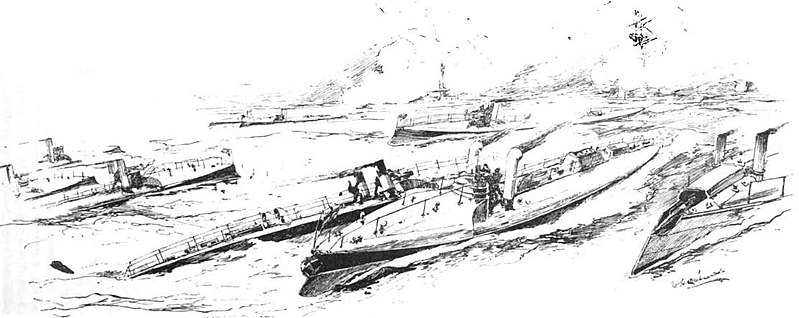
This chapter starts with two pioneers. They had been evoked in other related topics on torpedo boats, but it’s good to recall them and dive deeper into their history:
-Robert Whitehead, which turned Giovanni Lupis idea into reality, the locomotive torpedo.
-John Isaac Thornycroft: Shipbuider, which used a new innovative, light and fast steam machinery into the HMS Lightning, world’s first torpedo boat.
The famous little ship interested the Navy, less because of genuine use at present in the allmighty Royal Navy, but better to stay one step ahead of rival nations that certainly will soon embrace this new asymetric warfare asset. And indeed, all nations wishing to assess their power at sea did just that and adopted the “miracle weapon”, which could in one stroke, destroying a far more costly capital ship. Just like for the Dreadnought, Britain was not far from shooting itself in the foot, by enabling this cheap “leveller” into undesirable rivals. Among which was, the eternal one, France; Recently defeated by the Prussians in 1870, the old Nation under the guidance of Admiral Aube would soon embark into a massive new fleet of torpedo boats instead of classic assets, rather focusing funds on the army and “Revanche”. This was the Jeune Ecole. And without Britain it would not have been possible.
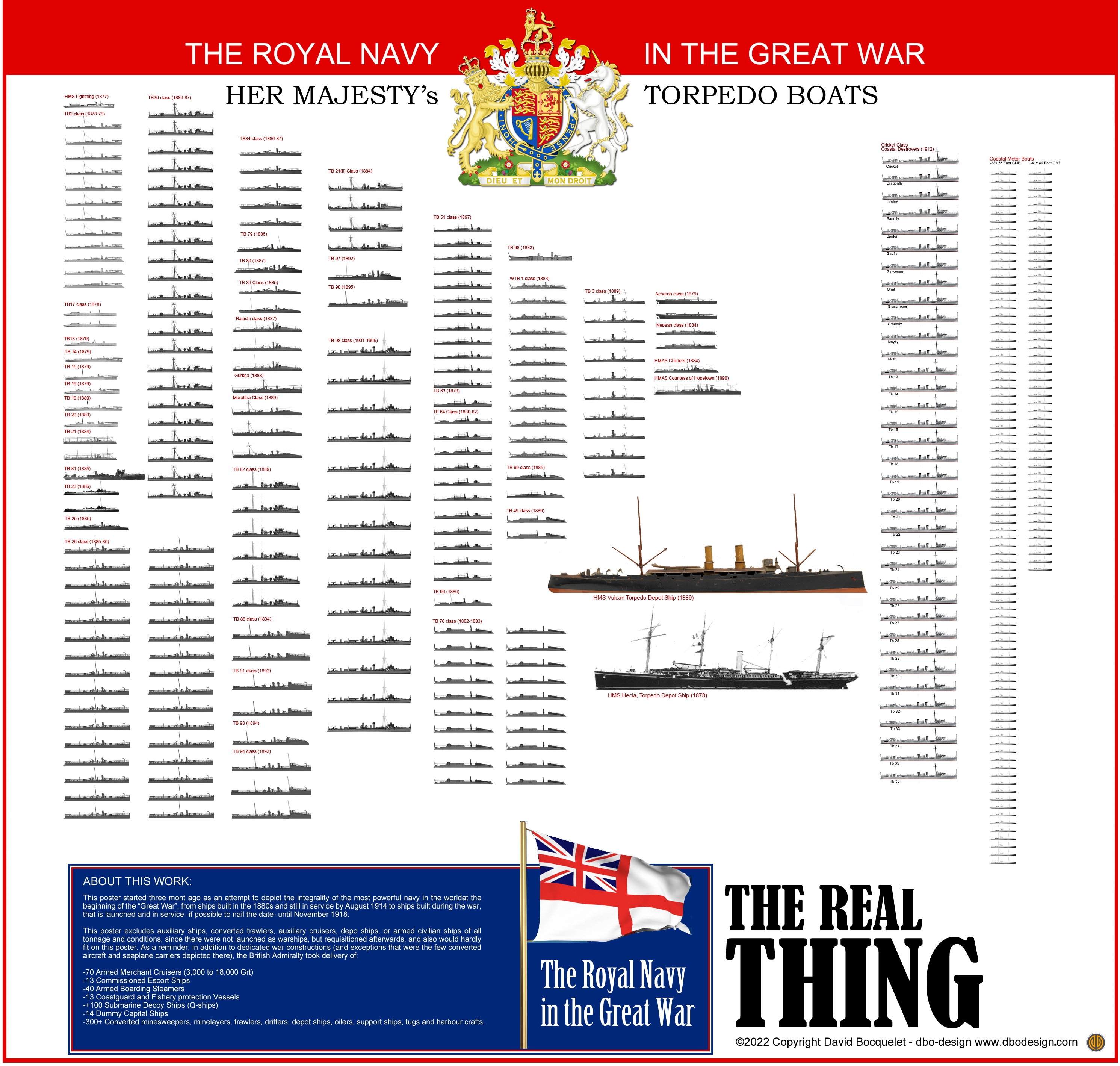
Poster of all British TBs prior to WWI, including the wartime CMB.
Granddady: The spar Torpedo Boat
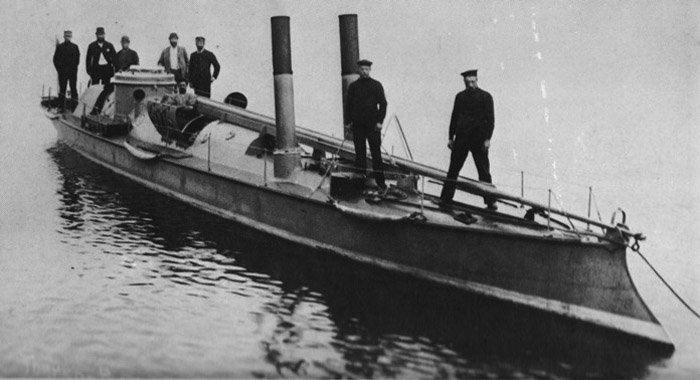
The experimental spare TB HMS protector
It’s well known an invention has many fathers. Nothing really ever came from the blue. Ideas of technology transfer, connecting the dots between several patents and concepts often results in what is called “invention”, but sometimes plain luck and/or a fortuitous event drives it also. So if the concept of “modern” torpedo boat is attributed to Britain, the term “torpedo boat” was found much earlier than these 1870s experiments. Ten years prior, both the North American Confereracy and the Union, pitted in a vicious civil war, tested small steam boats carrying “torpedoes” mounted on spars. The term at the time designated basically an explosive charge, inspired by biology, precisely electric fishes, rays, part of the Torpediniformes Genus. It is derived from the Latin word “torpidus”, meaning ‘numb’ or ‘paralysed’. A good way to describe the effect of such explosive on a warship, basically “dead in the water”.

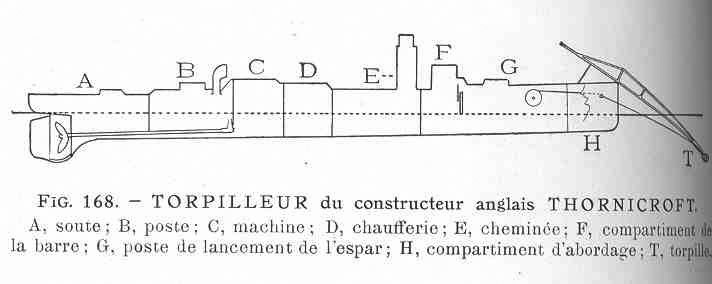
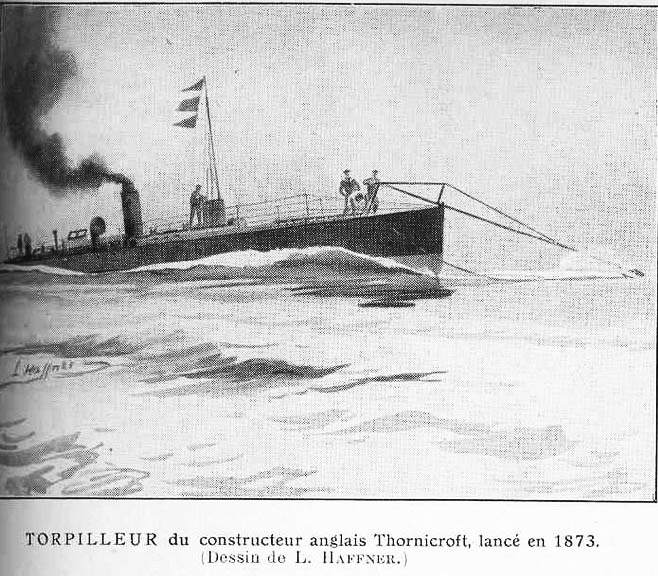
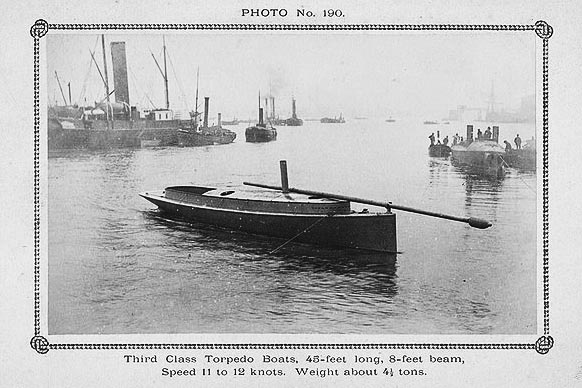
Various types of spar TB launches
So, the idea was just to place an explosive charge onto a ship’s flank or even better, belly. Early experiments dates back from 1812, notably with Fulton’s submarine, which carried such “torpedo” intended for British ships. But the way to detonate with a fuse or accurate and waterpoof retarding mechanism, was long. The spar, maintained above the water, simply using a wick long enough to escape to safety once the charge was somewhat hooked in place, or a distance-based detonation mechanism. Simply, a cable under tension between the carrying boat and torpedo would be automatically severed, releasing the tension to a hammer, igniting the charge.
The spar torpedo invention is generally attributed to American (Confederate) engineer E.C. Singer. He pioneered an explosive charge suspended from a pole around 10 feet long at the bow of the vessel. The attachment steel line to a trigger mechanism was released, after the torpedo was placed onto the enemy hull and while retreating to the extent of the steel line’s length, trigger did its office. Still, the steam launch behind was dangerously close. A more sophisticated system was adopted by Union, with the USS Spuyten Duyvil, which automated the whole process and was not only partly submerged, but also all-metal.
Overall, dozens of vessels used spar torpedoes, not only small steam launches, but also larger ships like monitors, generally in that case to blast apart riverine defensive obstructions, in particular in the James River. The Confederacy used them liberally, and devised clever vessels for such operations, the CSS David from Rear Admiral Dahlgren, and HL Hunley, generally regarded as the world’s first operational submarine with a confirmed kill.
Long story short, the widespread use and successes of this new weapon preceded the modern torpedo, and were still used operationally and tested until the end of the XIXth century: For example, Romanian steam launch Rândunica sank the Ottoman river monitor Seyfi on the Danube on May 26, 1877 (war of independence). Even later in 1884 French admiral Courbet used two spar torpedo boats at the Battle of Foochow, destroying the Fujian Fleet’s flagship Yangwu and the gunboat Fuxing, both by night at anchor. The Royal Navy went on testing modernized spar torpedoes, all metal with telescopic masts and longer cables, up to the end of the Century. Many navies adopted these in the 1870s, before swapping onto the “modern type”. Simply because the new type was complicated, and not trusted yet.
Development of the torpedo boats: Two pioneers.
Robert Whitehead, father of the “locomotive torpedo”
Now were had in mind the origin of the “torpedo” and its first uses, it should be noted that the concept dated back well before the American Civil war. In Europe, many engineers were looking of a better, safer way to dispense the explosive charge, based on early 1800s experiments. Giovanni Lupis is generally attributed the merit of the initial concept invention. Austro-Hungarian subject, Coratian-born Giovanni (Ivan) Biagio Luppis Freiherr von Rammer (1813-1875) in 1850 imagined the “Salvacoste”, a floating device for destroying ships that would be unmanned and controlled from land.
He believed it dearly and in fact, managed to create an early prototype, one metre long with glass wings and controlled via long ropes from the coast. But it was too heavy and cumbersome for this. Next, he created the original “Salvacoste”, with a clock mechanism as engine, driving the propeller, explosives in the stern ignited via a pistol-like control, two rudders, and again, coastal ropes guidance. 6 meters long, it did a little better. In 1860, undeterred, he retired from the Navy to focus on his idea. He made a demonstration with a new prototype using compressed air, to the Emperor Franz Joseph and a commission, which rejected it.
Enters Robert Whitehead (1823-1905). The Lancashire-born engineer at the time directed the “Stabilimento Tecnico Fiumano”, a technical workshop with a small factory. He moved after his studies in Manchester to Toulon at Philip Taylor & Sons and later Milan as consultant, and then Trieste, on the Adriatic coast. Crafty, he was noticed by the owners of Fonderia Metalli near Fiume and by 1856, became manager, producing very modern marine steam boilers and engines used by the Austrian Navy.
In 1863, Whitehead met Giovanni Luppis, just retired to Trieste. He was not long explaining his idea, and Robert to see the potential, with a small steam engine instead of a clock mecanism and compressed air. This enabled far more distance and no longer needed cables. The two men soon found common cause and entered partnership. But soon, Robert discarded entirely Luppis initial concept. Instead, with the help of his 12-year-old son, John, and a workman, Annibale Ploech, he experimented a Minenschiff, first self-propelled (locomotive) torpedo.
It was presented in 1866, just one year after the end of the civil war, which confirmed the use of the “torpedo”, to Austrian Imperial Naval commission, on 21 December 1866. This time, his prototype worked flawlessely, and the commission was impressed, purchasing prototypes to be tested on the gunboat, SMS Gemse was adapted at the Schiavon shipyard, Fiume, with Whiteheads patented launching barrels, forerunners of torpedo tubes. No less than 50 launches were performed at STT. In 1870 the very first all-patented, working Whitehead Torpedo was ready for service adoption. It was capable of 7 knots (13 km/h), reaching 700 yards (640 m), and powered by a small reciprocating engine run by compressed air, the only part kept from Luppis late design. There was indeed no way for a small steam engine to get hot and had enough pressure in time. A faster system was needed. It should be noted that Compressed Air was also the system chosen on the 1864 French submarine Plongeur.
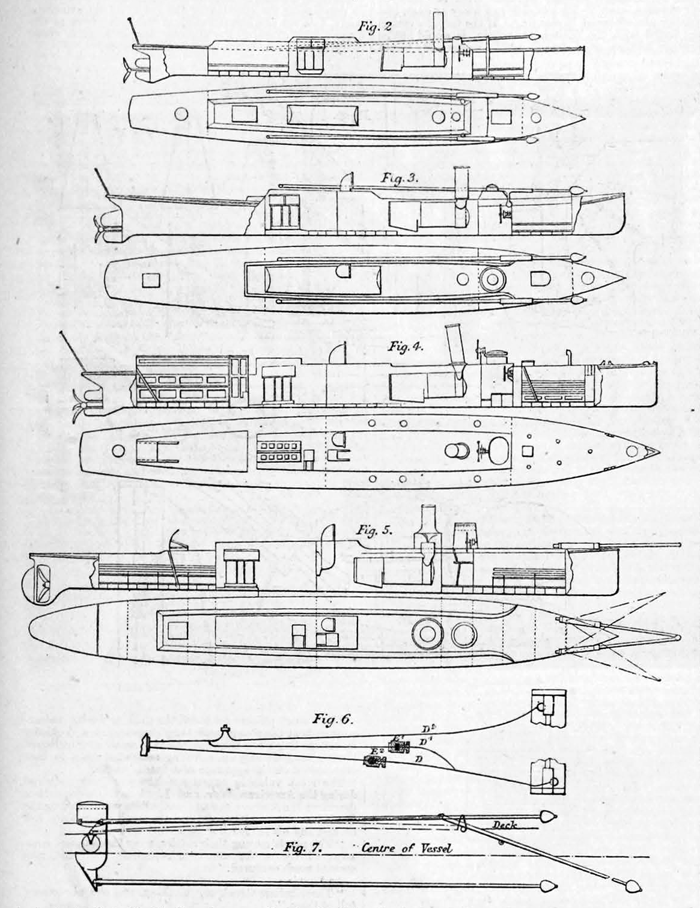
Various types of Thornycroft’s early designs, 1877
Soon, by its own volution and pressure from the Austrian Naval staff, strict secrecy surrounded his work. His workers had to sign a waver with rigid compliance to several rules. He meanwhile perfected further his model, bringing a self-regulating device for a constant preset depth using an hydrostatic valve, linked to a pendulum balance, connected in turned to the horizontal rudder, plus gyroscopic stabilisation to keep direction. Way later, Whitehead would adopt the patents of the 1898 gyroscope mechanism from Ludwig Obry. The paradox was that, instead of bringing him fortune, the long design process diverted him from his usual affairs, and Stabilimento Tecnico di Fiume filled a bankrupcy note in 1873.
Two years later he moved to Azioni and funded “Torpedo-Fabrik von Robert Whitehead”, later renamed Whitehead & Co. Completely focused on torpedo production and sales, this time he met success, as his product was purchased in droves -despite Austrian initial resistance- by all the navies that counted at the time. Money talked, but Whitehead took arrangements at least for the Austrian Navy to have a short exclusivity. Luppis, who at the time was no longer attached to the company in any way, never mad a cent in royalties.
In 1873, there was still plenty of interrogations about the carrier, and many navies simply transitioned from spar torpeo steam launches to the same with torpedo ‘tubes’ or simple launching cradles. These vessels were painfully slow. Enters Parsons & Thornycroft. Others thought there was no way to create a small but powerful steam engine with existing technologies and advocated torpedo cruisers, pioneered in 1880. Many solutions were found, and locomotive boilers, proven and compact, were part of it.
John Isaac Thornycroft
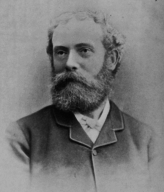 The father of HMS Lightning, world’s first torpedo boat.
The father of HMS Lightning, world’s first torpedo boat.
Born in 1843, a student in Regent Street Polytechnic & the Royal School of Naval Architecture and Marine Engineering (South Kensington) he worked on the steam launch Nautilus in his father’s study, a fast boat with a reliable engine. By 1862 it won the University race. The publicity helped his father puschasing a strip of land along the Thames near Chiswick the next year, with a Workshops for both. By 1866 Thornycroft extended over the whole Chesterman’s yard completely with the founding of John I. Thornycroft & Co, but John Isaac still worked mid-time at Palmers Shipbuilding and Iron Co., Jarrow-on-Tyne while pusrusing an engineering degreed at the University of Glasgow. After a marriage back from Scotland he built the fast steam yacht Miranda in 1871.
From there, he recieved orders for similar vessels like the Gitana (1876), capable of 20.8 knots (38.5 km/h; 23.9 mph), record breaking at the time. Of course the oyal Navy was not long before meeting the man and after he sold Rap to Norway in 1873, a spar torpedo vessel, he started to be interested in Whitehead’s self-propelled torpedoes by 1876 and designed HMS Lightning for Royal Navy’s tests. She was shaped like the yacht Gitana and immediately made breaking records. John Thornycroft’s influence on the torpedo boat design is monumental.
Still, he was not satisfied with the locomotive type boiler system which prevented for him reaching 22–23 knots (41–43 km/h; 25–26 mph) and worked on his own Water-tube boiler system, meeting a new record with the river-steamer Peace in 1882 (Herreshoff design) and it was ready to be sold in 1885, along with 50–60 patents. The Spanish TB Ariete for example reached 26.2 knots with these in 1887. By 1894 Thornycroft’s torpedo gunboat HMS Speedy became the first RN ship with water-tube boilers. He also nearly solved the rolling issue by 6-ton moveable watertank controlled by hydraulic cylinders (1892) and by 1894 had one employee nearly solving the effects of cavitation on HMS Daring. A new wider blade model emerged allowing speed up to 28.4 knots on the same power previous propellers only allowed for 25 knots.
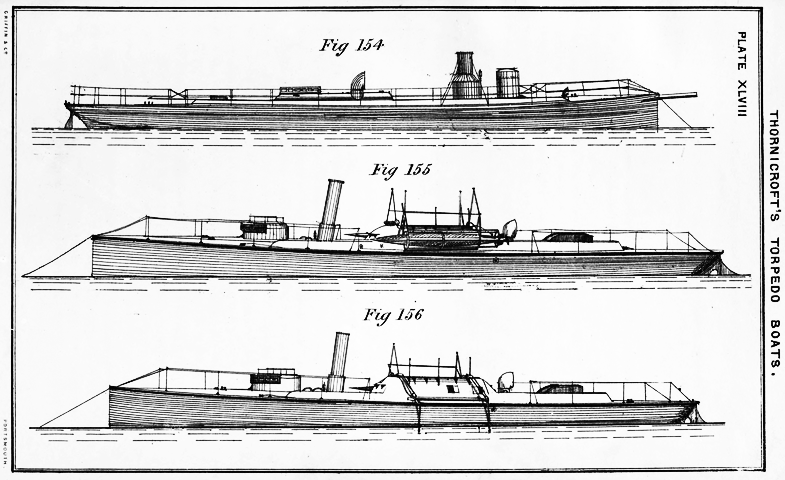
He also tested numerous hull-shapes, settling on a stepped hull for fast motor boats like those used by the RN WWI. In 1910, his 25 ft Miranda IV used a single-step hydroplane and from 120 hp (89 kW) reached 35 knots (65 km/h) already, another world record. In 1915, he resurrected the idea of a torpedo boat (after pioneering it) by having one of these Motor Boats equipped with torpedoes and thus invented the MTB for coastal service. By January 1916 he started production of the Coastal Motor Boats (CMB) and also worked on air-flow devices, hovercrafts and hydropters. His company was still recoignised as champion of MTBs in WW2…
Charles Algernoon Parsons
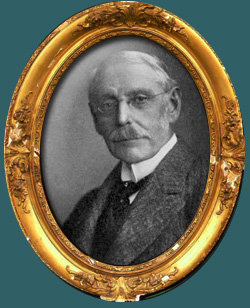 Father of MS Turbinia and the end of torpedo boats.
Father of MS Turbinia and the end of torpedo boats.
To close this topic, let’s cite a famous third pioneer, vital for the RN small ship’s inventory: Parsons was born into an Anglo-Irish family in London, his father being the famous astronomer William Parsons, 3rd Earl of Rosse. Educated at home in Ireland by private tutors, he attended Trinity College, Dublin and at St. John’s College in Cambridge, graduated 1877 before starting work at Newcastle’s W.G. Armstrong as an apprentice, then Kitsons, Leeds, on rocket-powered torpedoes. In 1884 he was hired by Clarke, Chapman and Co., ship-engine manufacturers near Newcastle. From the electrical-equipment dept. he developed a turbine engine that same year to drive the electrical generator he designed.
This was revolution, more efficient than the one invented by Gustaf de Laval (1845–1913) working on an impulse design and did not worked due to the materials of the time. Logically, in 1889 he founded C. A. Parsons and Company in Newcastle to produce his turbines, that he scaled up and improved constantly, and the Newcastle and District Electric Lighting Company (DisCO) later opening in 1890 the world’s first power-station using turbo generators. In 1894 with patent rights from Clarke Chapman he rapidly improved the poor efficience of the first model (1.6%, 7.5 KW) to a megawatt turbine in 1899, and seeing fruitful prospects with the Royal Navy he also founded the Parsons Marine Steam Turbine Company, also in Newcastle.
Enters Turbinia
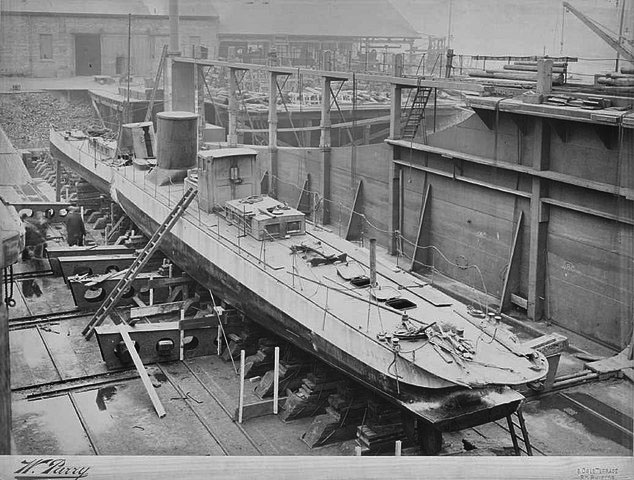
The Turbinia in construction
In June 1897 he had a his personal yacht experimenting a turbine, named “Turbinia”. He made a publicity stunt by turning up unannounced at the Queen Victoria Diamond Jubilee, and made a splash by being spotted by all present at the Navy Review in Spithead, this 26 June 1897. He attracted the attention of the Prince of Wales, foreign dignitaries, and Lords of the Admiralty, moving at 34 knots (63 km/h; 39 mph) while the fastest ships in the RN at the time reached 27 knot (50 km/h; 31 mph). But he achieved this not only based on the efficience of his turbine. The latter was narrow and he created a slender hull around like a glove, making the Turbinia an unbeatable “greyhound”.
Needess to say, the Admiralty was impressed, and despite its policy disregarding light ships at the time, just to avoid such design falling into foreign hands like Russia, France or Germany, two orders were rapidly made to Parsons the next years: These were scaled-up to carry two turbines each: The destroyers HMS Viper and Cobra. He also received an order from a civilian yard to have the first turbine-powered passenger ship, the TS King Edward, in 1901. What followed were the turbine-powered transatlantic liners RMS Victorian and Virginian (1905) and of course HMS Dreadnought in 1906.

The Turbinia at sea, at full speed. The world’s first turbine-powered vessel. By that stage, the torpedo boat era was over in Britain.
So what caused the end of Torpedo Boats in the Royal Navy ?
The prodige that was turbinia however only affected late British destroyer designs: After HMS Cobra, the admiralty built the River class, which innovated by replacing their traditional turtleback forward section, low above water, but a proper forecatle, inaugurating the classic shape that would be copied by all. With this new hull and Parsons’s turbines, this was a match made in heaven. But this did not affect torpedo boat production, which was halted altogether. It was decided indeed these new destroyers could blend the role of both in the same package, the standard torpedo ship the fleet needed as an escort.
Indeed, Palmer Yard’s first batch with HMS Erne completed in February 1904, mirrored the fact the very last 1st class Torpedo Boat, TB-117 was made by White and launched in 1905. As for the 2nd class, the last was the colonial TB HMS Countess of Hopetown made by Yarrow in 1890 for the South African station (see later). The main reasons seemed to be based on technico-economic grounds: The size, cost and complexity of a turbine for a torpedo boat. The second main reason was of course that destroyers by themselves could take on better the tasked of the torpedo boats. TBs were still seemed to be cheap and useful however for point defence and thus, ended that way, but the fleet needed destroyers and focus simply turned to these, ending the craze for torpedo boats just like the contemporary torpedo cruisers. They were seen largely as a technological dead-end.
As for the turbine, it was already available and a single, smaller model probably would have fit into the belly of the 1900 160-footers, but the design was mostly done when HMS Viper and Cobra were tested (the latter in 1902). And so, since the admiralty decided already to get rid of this type for destroyers only, the next generations, possibly “170 footers”, turbine-powered, never saw the light of day. The turbine was just too complex and costly for these cheap vessels, which did well to reach 25 knots until then with way cheaper and classic VTE engine. None was also ever equipped with J. Thornycroft’s watertube boilers, although many were later modernized with those in the early 1900s.
Design specifics
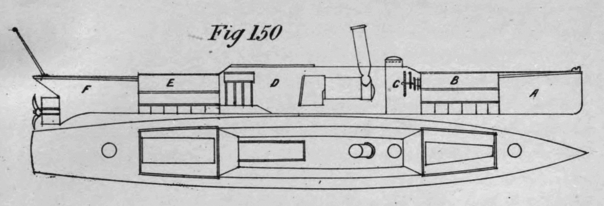
Norwegian spar-torpedo boat Rap, 1873.
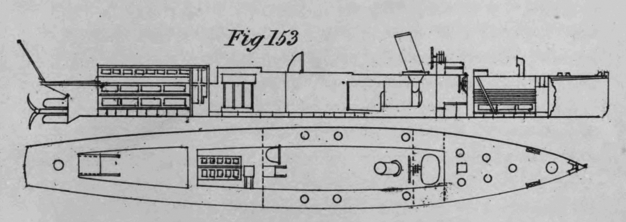
HMS Lightning’s internal scheme
The British Torpedo Boats were derived from a civilian Yacht which preceded Thornycroft’s HMS Lightning, called the “Gitana” a Yacht operating on Lake Geneva, which calm waters were ideal for long runs and speed tests. But also the “Rap”, a Norwegian spaer-torpedo vessel, which had a stronger construction and was more utilitarian. The Lightning was roughed up to fit the admiralty needs and thus still had many of its civilian heritage perks, notably luxurious internal wooden paneling and fixtures, all of which were eliminated on the first serie, the TB 2 class (Thornycroft 1878 model).
Technically, construction was classic, calling for steel framing, with a light skin steel paneling. There were concerns to make the structure lightweight, notably to compensate for the enormous weight of the steam engines at the time, using massive foundry pieces, cast iron and even lead. It was no wonder the powerplant was installed right in the center of the boats for stability.
The prow was generally straight, and in rare case “swan like”, meaning curved in a bow like shape, but not reinforced. They were certainly not rams. The draft was variable, since with speed, most of the boats forward was almost over water when at full speed, and the greater depht was aft, at the rudder level. The latter changed in time and shape. The earlier ones were divided with the single propeller shaft passing though it. Later a larger rudder was installed at the more conventional “cruiser stern”, succeeding to the early clipper stern of the 1870s TBs.
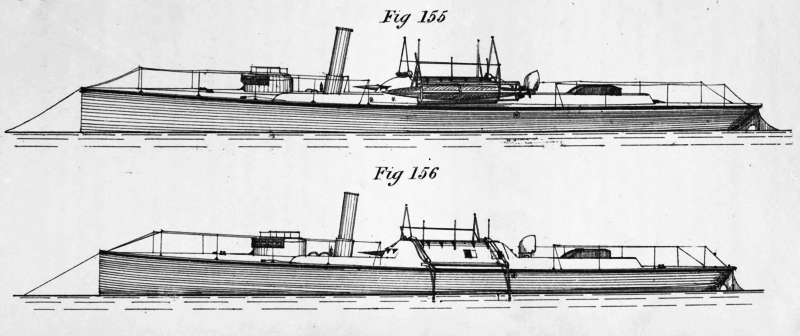
Early Thornycroft designs
The advantage of the new rudder was it’s manual backup with a bar mounted on the aft deck. Another perk of the design was that the crew was housed in the single level hull, with minimalist superstructures: There was in common to all at least a small conning tower, with minimal armour to be usable by the captain under small arms and shrapnel fire. But the standard position was behind it, standing with a wheelbar. Apart the storage space for torpedoes, and later supplementary axial torpedo tubes, there were only access hatches below, funnels and air intakes. They also had all a single pole mast to be rigged for signals, either close to the conning tower or aft.
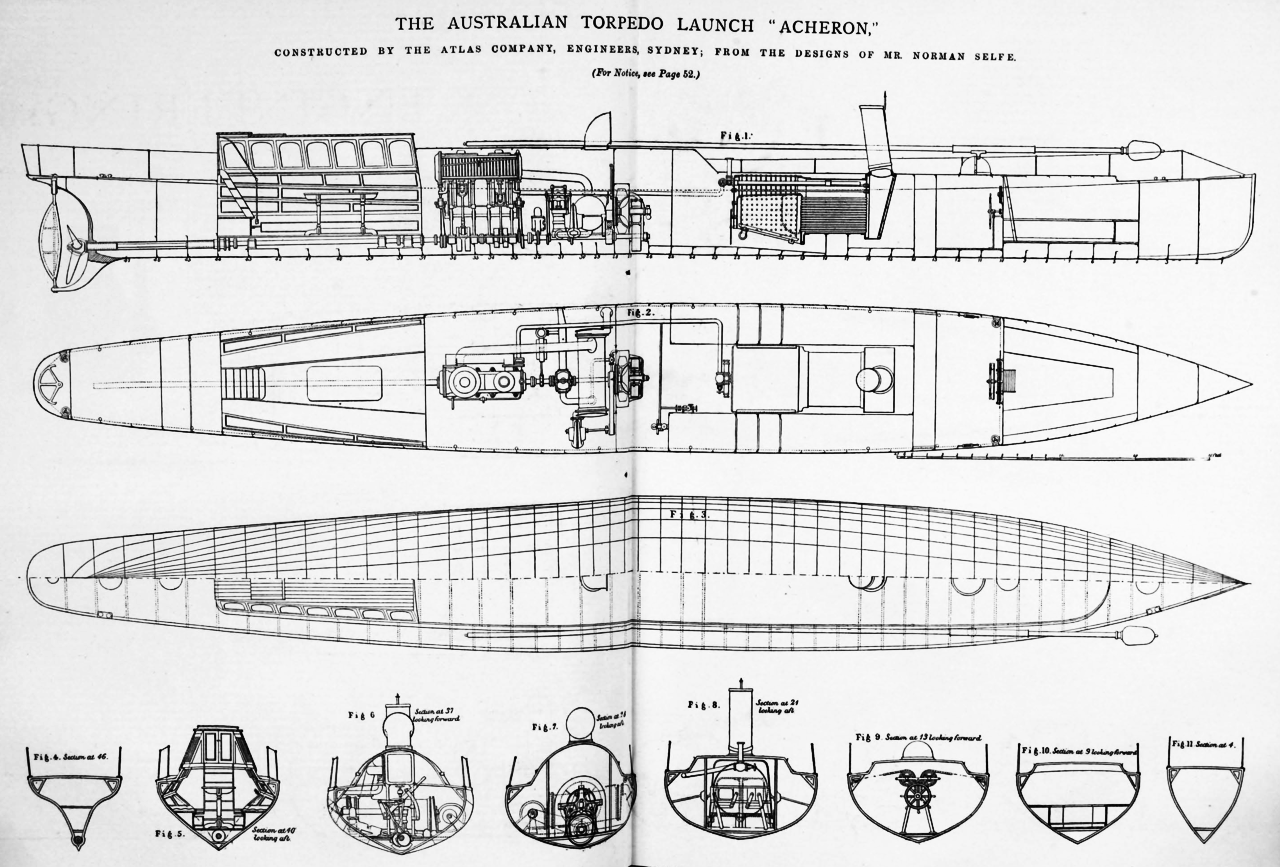
Internal accomodations of HMAS Acheron, Australian-built 2nd class TB
As for internal accomodations, officers’s living quarters were spartan and in the forward section, while the rest of the crew lived in a single space aft, above the propeller shaft, between storage bunks, a table and hammocks. There were limited facilities and storage as most of the time, these boats were used to a one-day sortie or a 48h patrol. All the rest of the space along the flanks was taken by coal.
Powerplant
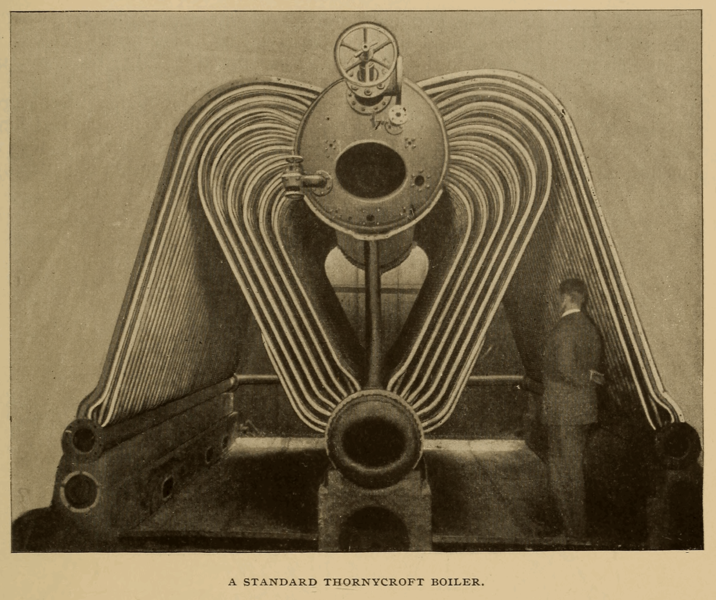
Thornycroft’s watertube boilers. They started to replace classic locomotive single-ended boilers for compound and VTE engines in the 1890s and 1900s, and went to oil-firing with the Cricket class in 1905.
HMS Lighting had a Compound engine and the following the same, with yards variations and powers going from 330 to 550 hp. Speeds ranged from 16 to 22 knots, but engines were worrn out after ten years and performances rapidly deteroriated, with their “loco boilers” replaced when possible by VTE or later watertube boilers in the 1890s. The 113 footers were given the same, as the 125 footers and greater machinery power giving 700 ihp to compensated for twice the displacement. They still maintained up to 21 knots. The experimental Yarrow’s TB 79 introduced a vertical tubes engine (VTE) and better double-ended boilers to reach a symblic 1000 ihp and 22.5 knots in 1886.
Suceeding to the “war scare” 125 footers, the late 1880s Yarrow boats of the TB 80 and 81 types innovated between their turtleback bow and VTE engines. The next 130 footers had the same but up to 1800 ihp for 23 kts and in between the hull lines were refined and the structure reinforced in 1884 as their weakness and lack of seaworthtiness were blatlant. The 1890s 140 footers by Yarrow and Thornycroft were all fitted with VTE engines with a gradual improvement from 1500 to 2000, then 2350 ihp on the TB 91 series. The goal was not to at least sustain 23.5 kts and if possible reach 25 knots; This was only relaized by the next decade 160 footers, still with VTE and water tubes boilers fitted when possible. They reached 25 knots based on 3000+ ihp. Of course perfoormances degraded and consumption exploded as soon as the weather became foul.
Armament
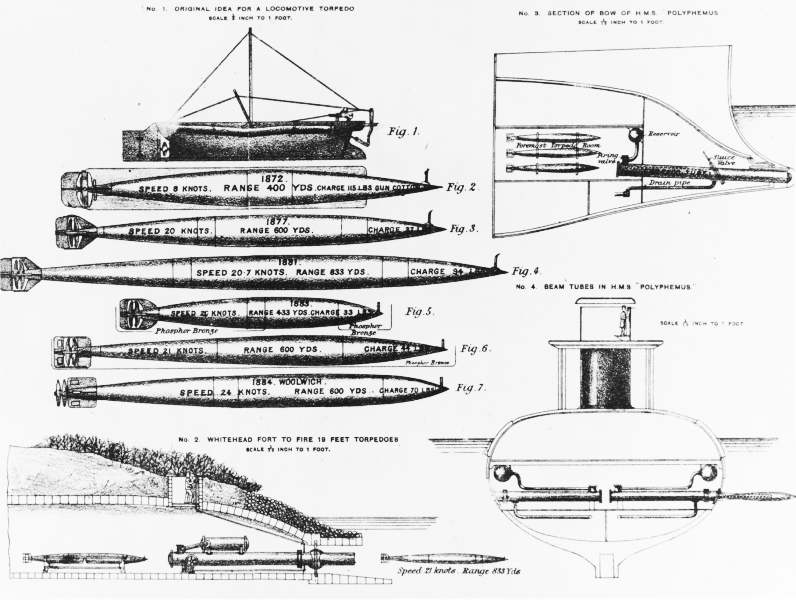
Early Torpedo types chart 1870
Torpedoes
HMS Lightning (TB 1) was so small she had no armament past the torpedoes. The first were in drop-collar but soon a single forward tube on a traversing pivot mount became the norm. Spares torpedoes aft needed to be carried vua pulleys and crew’s effort forward for reload. Later, these were placed in dropping gears as to be used too. The 125 footers introduced fixed tubes forward with ram bows, and those became the norm, albeit with straight stem and turtleback, allowing internal, safe reload. Generally two torpedoes were carried forward, two aft, later in dropping gears. TB 80 innovated by having two side tubes with some traverse aft on deck, and a fixed bow tube.
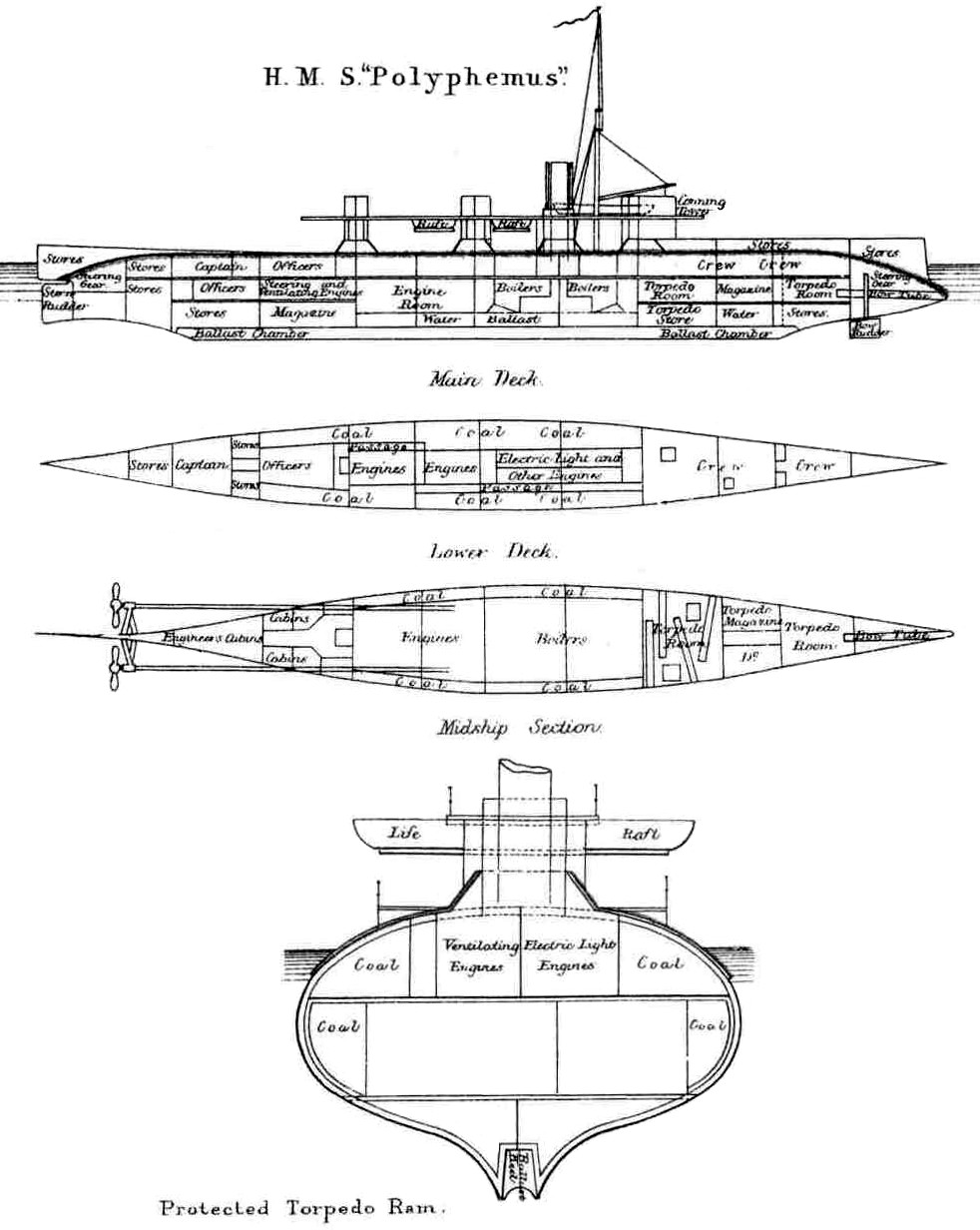
HMS Polyphemus, another interesting alternative using torpedoes.
As for the models, these were of course Whitehead Mk.I models 14-in caliber, constantly improved. The late 140 and 160 Footers however were equipped with the Whitehead 18″ (45 cm) designed from 1888, but only entering service in 1894. It weighted 845 lbs. (383 kg) for 140 in (3.556 m) in lenght, and carried a 118 lbs. (53.5 kg) wet gun-cotton warhead at 800 yards at 26.5 knots, powered by a cold running Air-flask (compressed air) feeding three cylinder: The radial Brotherhood pattern engine.
In WWI these were possibly upgraded for the surviving ships with the 18″ (45 cm) Mark V (1901) weighting 1,353 lbs. (614 kg) and carrying a 296 lbs. (134 kg) charge, also air-compressed.
Artillery:
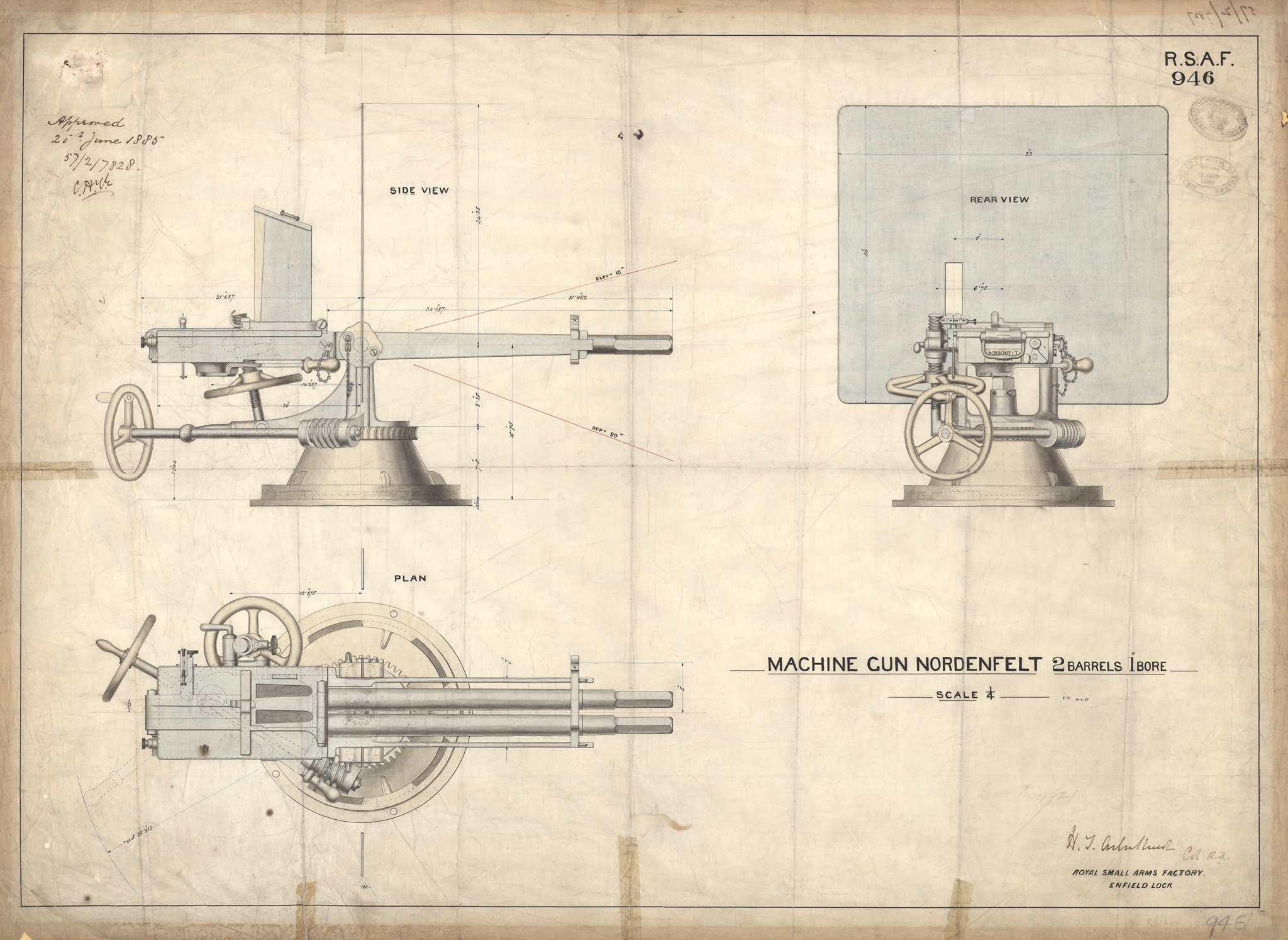
Defensive armament was pretty unheard of until TB 39 by Yarrow. The 1882 and 1885 TB 40 had two 1-in (25 mm) Nordenfelt hand-crack Palmcrantz twin barreled heavy machine gun. Weighting 447 pounds (203 kg), pivot mount they fired 7.25 ounces (0.206 kg) solid steel bullets with brass jacket at 1,464 feet per second (446 m/s), with a rate of fire of average 120 rpm. In reality when targeting a small point, this was rather 20 rpm at sea.
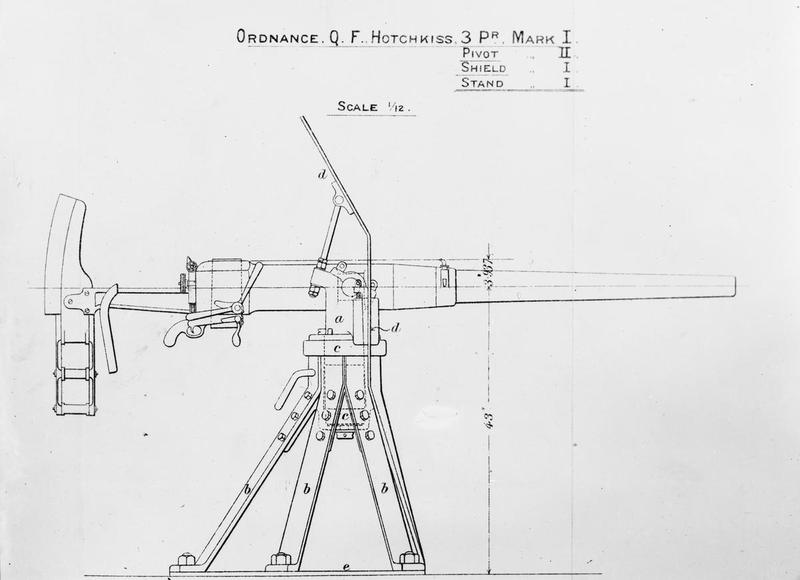
From the large TB 80-81 onwards, for the first time 3-pdr (37 mm) Hotchkiss guns were introduced. These Vickers RF guns replaced the Nordenfelt when possible. Typically one was mounted on top of the conning tower at the end of the turtleback prow, and/or aft, both centerline. Two small Nordenfelt were installed on either side when there was enough room. The 160 footers had three 3-pdr, two on either side of the conning tower at the end of the turtleback bow, behind bulwarks and a single aft with a much greater arc of fire. The conning tower top supported a projector for night actions. src
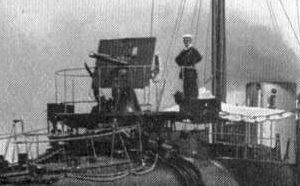
The exception were the 1915 Cricket class: coastal destroyers (1905) Reclassified as TBs in 1915, these small boats had two 12-pounder guns (76 mm) Vickers Arsmtrong Elswick and three 18-inch torpedo tubes of the later model described above.
1905: The last British Torpedo Boats
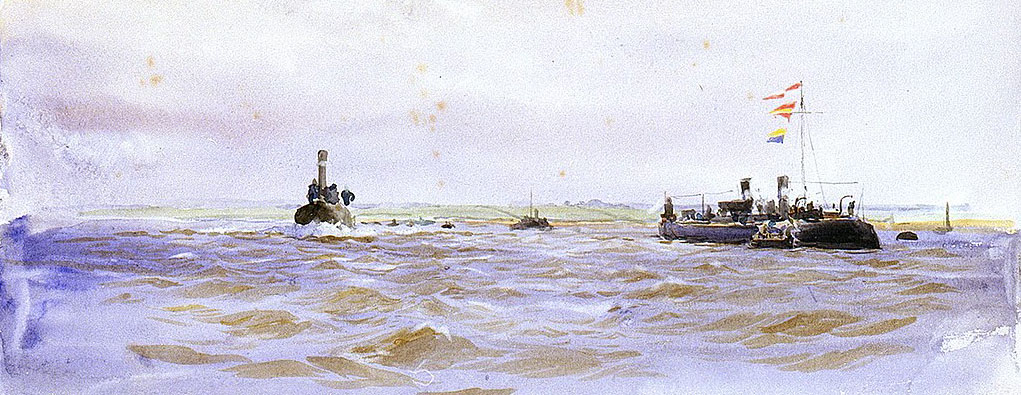
TBs in the Medway, 1894 -CC painting
Just as HMS Dreadnought was laid down, pioneered by Admiral Sir Jackie Fisher, the very last British Torpedo Boat, at least in this traditional shape initiated in 1876, was launched. This was HMS TB 117. Unnamed, as were all TBs but a few early exceptions, these were part of the thirteen “160 footers” ordered from White and Thornycroft, launched 1900 to 1905. So why stopping there ?
Reasons were many, chief of these simply the introduction of scored of torpedo boat destroyers, which incidentally also carried torpedoes, and were just larger, faster, better armed, more seaworthy, with better range. They proved more useful and could take on the tasks of the TBs while keeping pace with the fleet, the traditonal TBs could not.
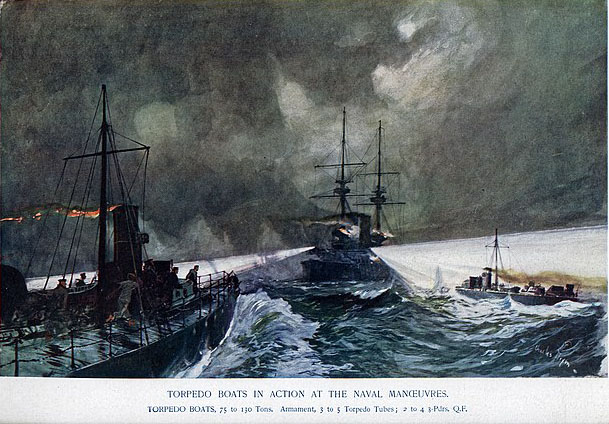
Charles Edward Dixon RN TBs in manoeuvers
The first “TB destroyer” was strickly speaking not British but Spanish, the 1885 “destructor”, built in Britain. After a short venture into Torpedo Cruisers in 1886 with HMS Rattlesnake, the Grasshopper, Sharpshooter, Alarm and Dryad classes launched 1887-94, the same year, Yarrow just perfect compact high pressure boilers enough to fit them into basically and enlarged torpedo boat: The 26-knotter HMS Havock class. These were also “180 footers” so technically designated sucessors of the 160 footers we just saw. This looked almost like a seamless transition.
Second, there was a swap in policy and Fisher (and others) had spent the initial virtues of the concept. After the failure of HMS Vulcan sole attempt to provide the fleet with an organic defending fleet of torpedo boats, they seemed condemned to harbour and coastal defence only and gradually lost their usefulness. More resources were now channeled into extreme destroyers like HMS Swift and naturally HMS Dreadnought, or the more promising submersible, just adopted from John Holland. Fisher proved instrumental in this transition. Though, British TBs of the last generation were still in service in WWI. The 140 and 160 footers found utility in point defence in colonial waters and harbours, such as Gibraltar or Alexandria, Colombo or Mumbai.
However if the classic torpedo boat was dead, John Thornycroft experiments with new hull shapes, combined with lighweight and powerful aviation engine just resurrected the concept of torpedo boat, with the Coastal Motor Torpedo Boat concept built in serie during WWI and still experimented on various designs in the interwar, until he passed away. This resurrection would have to wait until 1916, and this new breed, quite different, nimbler and way faster would have a long lineage, going through WW2, the Cold War, and still active today as the Fast Attack Craft (FAC).
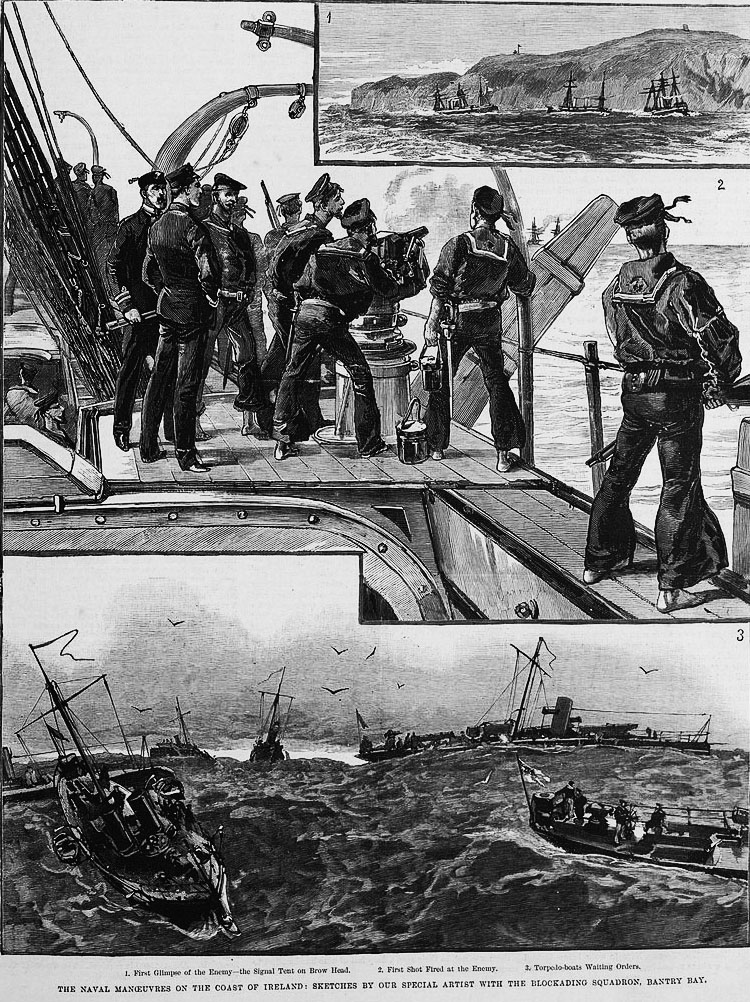
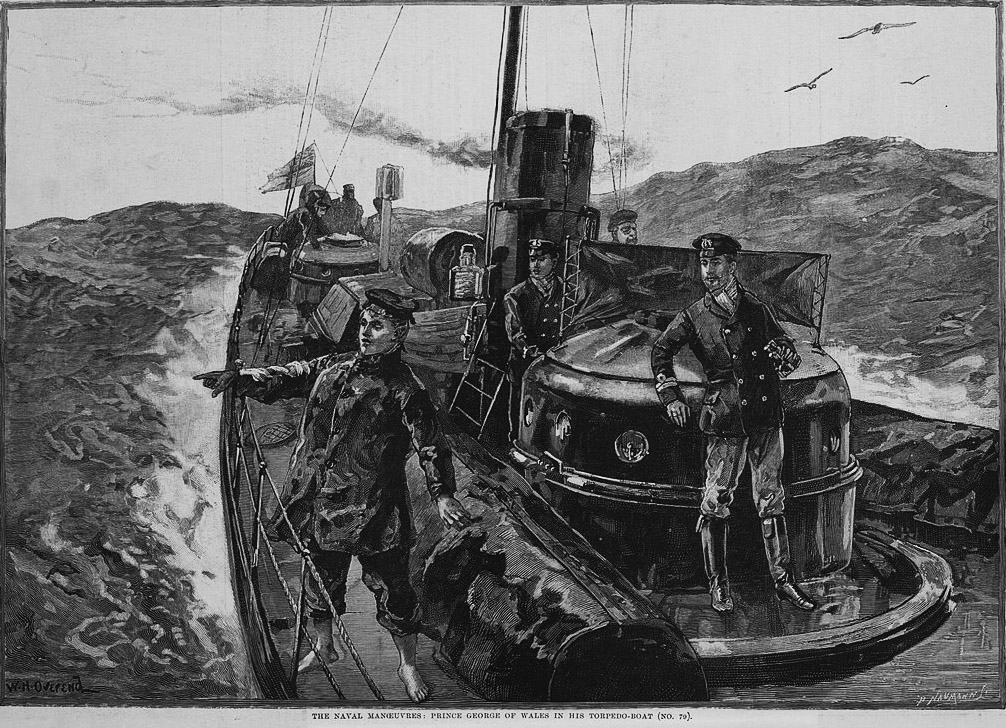
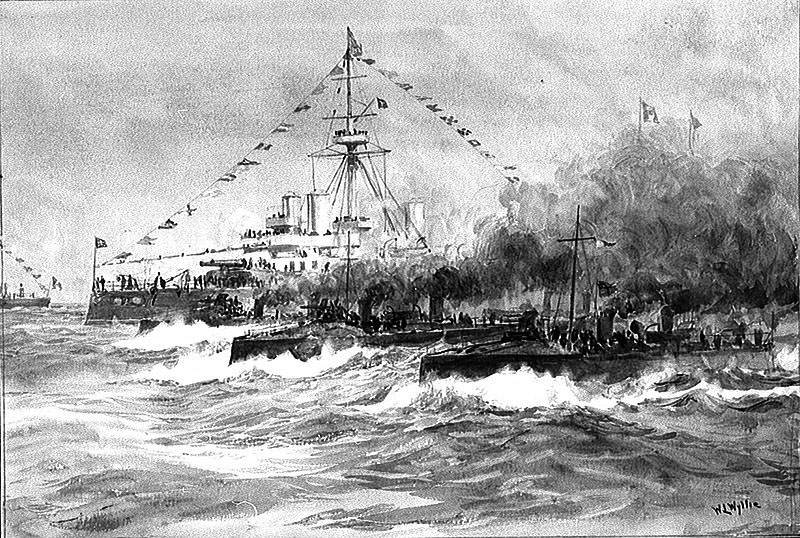
The torpedo depot ship HMS Hecla
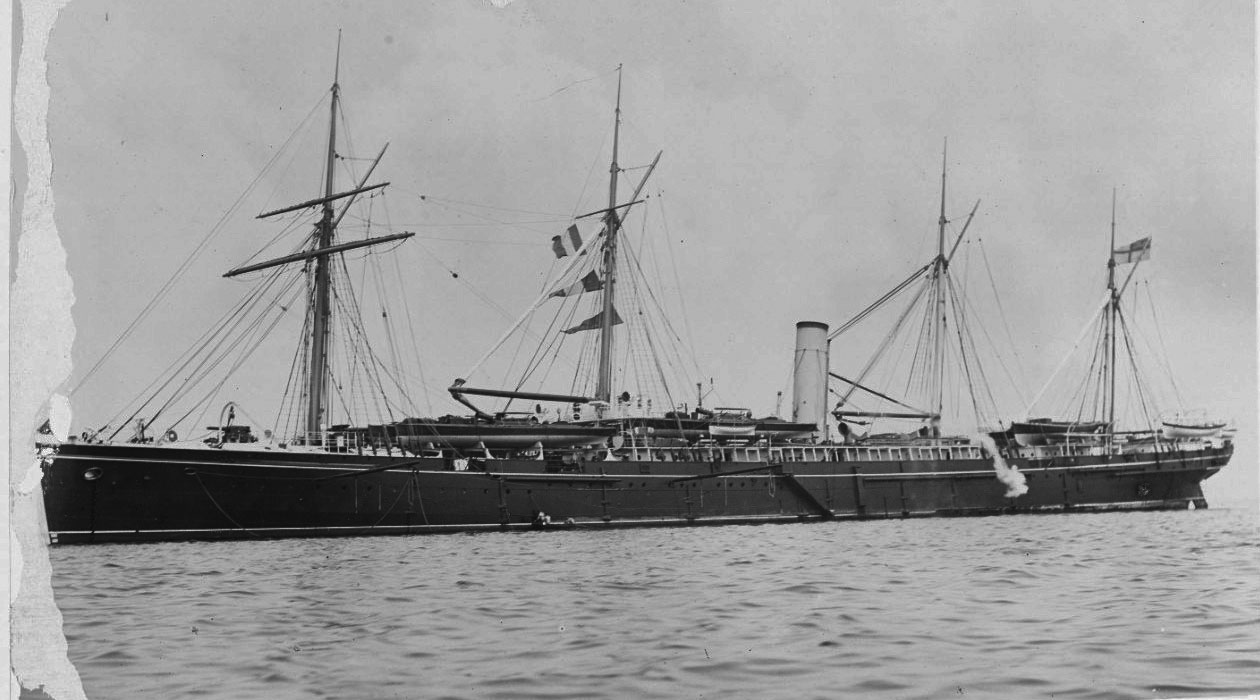
HMS Hecla (1878) was a torpedo boat carrier and depot ship purchased in 1878 for this purpose. The idea of carrying torpedo boats on a mothership was to some sort of dynamic fleet protection not only in open sea but also at anchor when the fleet was in transit in a possible dangerous area. There were multiple applications, chief of which was an enemy harbor attack, but some conditions needed to be met: The Torpedo boat needed to be small enough to be carried aboard -on this chapter the goal was achieved- and still be capable of operating with the fleet.
Hecla was the former merchant ship British Crown, requisitioned and converted whilst under construction by the admiralty. The hull was modified with a new aft section dedicated to carry up to six 2nd class “torpedo boats”.
Considered a bit as a “secret weapon”, the ship was stationed (like her purpose-built sister HMS Vulcan) in the Mediterranean, where sea conditions were more lenient. HMS Hecla was given to the best officers in RN especially experts in torpedo boats. Under their guidance, they conducted scores of tests. But like HMS Vulcan, conclusions were the same: Despite the merits of the solution, 2nd class TBs needed absolutely calm weather to operate. They were still slow and lacked capabilities to achive their missions in a wide range of circumstances. HMS Hecla was transformed in 1912 as a destroyer tender, eventually sold in 1926. See also.
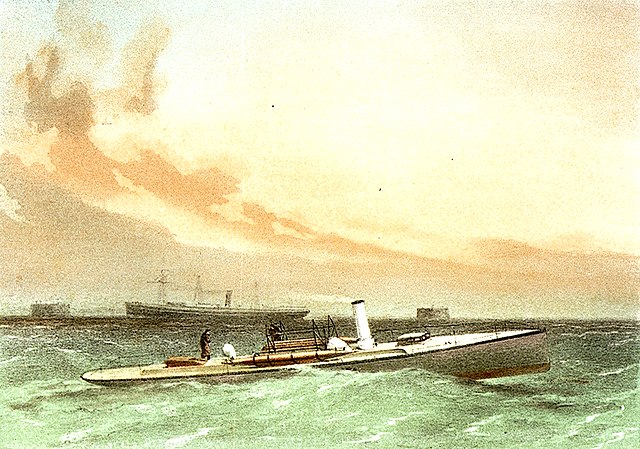
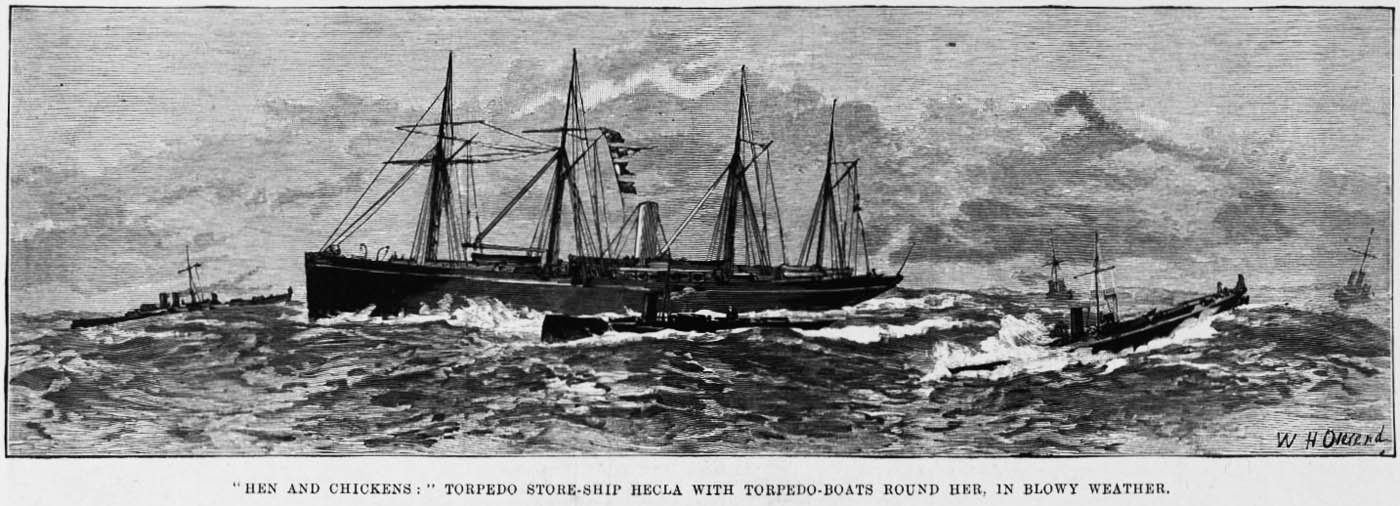
Specs
Tonnage: 6,400 tons
Dimensions (h:w:l): 391 x 39 x 24 ft (119 x 11.82 x 7.42m)
Powerplant: 2 shafts compound 2400 ihp
Speed and Autonomy: 13 kts, unknown
Armament: 5x 64 pdr, 1x 40 pdr, 6x TBs.
The mothership experiment: HMS Vulcan

Unlike HLS Hecla, Vulcan was a purpose-built mothership, a bit like the French Foudre. She looked like a cruiser and was well armed, but kept the same aft modifications to carry six 2nd class TBs operated by a large gooseneck crane. She also had a workshop and full equipments as a depot ship. Unlike Hecla, she was more specialized into fleet combat and intended to deploy her torpedo boats organically in a squadron.
Built at Portsmout NyD, laid down 18 june 1888 and launched in June 1889, trials took time due to boilers issues and the in(house “battle of the boilers”. She eventually was reboilered and arrived in service more than ten years after HMS Hecla, which already proved the limitations of the concept. Her service was further delayed by strenghtening the hull and curing her of teething problems past 1903. By that time the days of the 2nd class TB were over and those of the type in general were counted. She also operated in the Mediterranean, only making a few tests with TBs before being transformed as a submarine tender, a role in which she operated in 1915. In 1931 she became a training hulk and she was BU in 1955 named Defiance III.
Specs
Tonnage: 6,600 tonnes
Dimensions (h:w:l): 373 x 58 x 22fr (114 x 17 x 6.71m)
Powerplant: 2 shafts TE 12,000 ihp
Speed and Autonomy: 20 kts
Armament: 8x 4.7 in, 12x 3-pdr, 2x 14-in TTs, 6x 2nd class TBs
Early Torpedo Boats
 HMS Lighting (1876)
HMS Lighting (1876)

HMS Lightning at the Royal Science Museum.
The founding father: Before HMS Lighting, “spar torpedo boat” was a familiar term to all admiralties. These small launched could pack indeed a deadly punch, but their used was daring to the absurd, with as many risks for the pilot and crew than for the target ship. In “special operations” by night however in the right circumstances, they could do wonders. However in 1874 Robert Whitehead in the Adriatic changed all this, with his “locomotive torpedo”. Now, only a faster ship than usual steam launched to operate such promising new weapon ws required. This was John Thornycroft’s idea.
And thus, from his Miranda and Gitana, both civilian vessels, he was asked by the Royal Navy to marry both concepts. The test ship was named HMS Lightning, a fitting name sounding like a combination of speed and utter destruction. But technically, the Royal Norwegian Navy indeed had Thornycroft’s HNLMS Rap, delivered in 1873, three years before the British prototype. She was however a spar-torpeo vessel, as Whitehead’s model was not ready yet, but between the hull shape and technical details, she really was fast and modern for the time, certainly the world’s best spar torpedo vessel ever built.
HMS Lightning was built by John Thornycroft at Church Wharf, Chiswick and entered service in 1876, the first seagoing vessel armed with self-propelled Whitehead torpedoes. But with her solid military-grade compouned engine and the weight of torpedoes and equipments, she was not as nimble as previous yachts and her final top speed only was 19 knots.
When integrated definitely in an active unit she became Torpedo Boat No. 1. and was rated a a second class. Originally built she had no torpedo tubes, but two drop collars for launch. Thornnycroft knew this solution was not ideal and proposed in 1879 to replace these by a single torpedo tube, located on a pivot at the bow.
The two reload torpedoes were stored amidships. The reloading operation was fastidious though. The idea she would launch, and then use her fast speed to retreat far enough for this reload to proceed out of harm. As a ship, after extensive trials proving the concept, Thornycroft’s little wonder spent the remainder of her active life as a tender to the torpedo school HMS Vernon at Portsmouth, but still was used for extra experiments. She was BU in 1896 and therefore never saw WWI, like most 1870s torpedo boats.
Specs, HMS Lightning
strong>Tonnage: 32-1/2 ton
Dimensions (h:w:l): 87 x 10-1/2 x 5ft2in (26.52 oa x 3.28 x 1.57m)
Powerplant: 2-cyl Compound engine 460 ihp (340 kW)
Speed and Autonomy: 18.5-19 kts, range unknown, about 100 nm at best.
Armament: Two drop collar 14-in (356 mm) torpedoes (1879 1x torpedo tube).
 TB 2-12 (1878-79)
TB 2-12 (1878-79)
The first serie. TB 2 and following was improved sister ships built with a variety of features asked by the admiralty. They does not have the coach top aft and less wooden furnitures and fittings, for a more martial outlook, and her pivot torpedo tube at the bow from the start. But the size and general hull shape, dimensions were about the same. TB 10 differed from the pack by her ram bow, and in general they were considered “very fair seaboats” although only fit for coastal operations in calm weather. Their compouned engine wore rapidly, so much they could barely reach 16 knots in 1886, making them obsolete. To augment their capacity they received two torpedoes in a dropping gear in addition to the bow tube. Spread out between colonial outposts, in Gibraltar, Hong Kong, and the Cape, they were BU between 1896 and 1906, also missing WWI.
Specs TB 2-12
Tonnage: 28 tons
Dimensions (h:w:l): same but 10-1/2 ft x 5-1/2 ft (3.12 x 1.60)
Powerplant: Same, top speed 20 knots.
Armament: Same.
 TB 13-18 (1878-80)
TB 13-18 (1878-80)
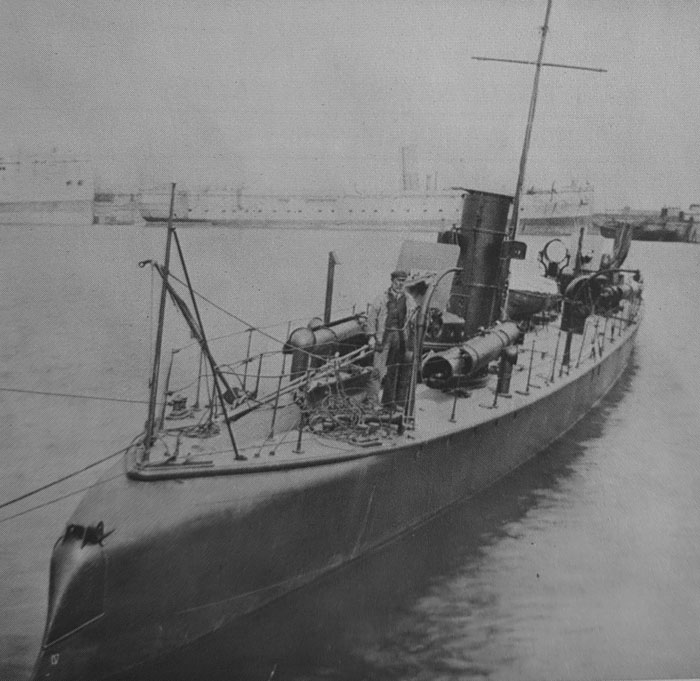
Convinced to pursue the effort, the Admiralty decided the design was too important not to entust other yards with the same design, owing the capacity of Thornycroft at the time, and wanted to make comparative tests for tech and cost and determine additional yards suitable for a possible mass production in the future. Thus, they ordered one each to the following: Maudslay, Yarrow, Hanna, Donald & Wilson, White, and Rennie in order. This determined Maudsley’s TB 13 was a very poor seaboat, slow, rolling excessively.
In 1886 this 28 ton boat was limited to 11 knots, BU 1896. TB 14 by Yarrow did much better. The best of the Batch, she reached 21.5 knots out of 550 ihp, and was BU in 1904. TB 15 by Hanna & Co was not judged superb and sent out to the Cape for local defence. White’s TB 19 was also good, also less than Yarrow’s. and she was the longest at 93 feets, reaching 21 knots. She was discarded in 1886 and BU in 1899. Rennie’s boat was powered by 360 ihp and thus slow at 16 knots and not agile at all. She was sent to Hong Kong and scrapped in 1903.
Thus, they ordered one each to the following: Maudslay, Yarrow, Hanna, Donald & Wilson, White, and Rennie in order. This determined Maudsley’s TB 13 was a very poor seaboat, slow, rolling excessively. In 1886 this 28 ton boat was limited to 11 knots, BU 1896. TB 14 by Yarrow did much better. The best of the Batch, she reached 21.5 knots out of 550 ihp, and was BU in 1904. TB 15 by Hanna & Co was not judged superb and sent out to the Cape for local defence. White’s TB 19 was also good, also less than Yarrow’s. and she was the longest at 93 feets, reaching 21 knots. She was discarded in 1886 and BU in 1899. Rennie’s boat was powered by 360 ihp and thus slow at 16 knots and not agile at all. She was sent to Hong Kong and scrapped in 1903.
Also of note, TB 16 was ordered to Lewin & Poole but never delivered on time, and thus cancelled. The number was later reused by Yarrow. TB 21 was never accepted. Built by Des Vignes on time, she proved to be a bad seaboat, too slow for operational service.
Also of note, the case of TB 17 and Tb 18. These were two copies of TB 14 for the Russian Imperial Navy during the Russo-Turkish war, but the war scare had them requisitioned and renumbered. However they were describes at the time as “norotiously shaky and weakly built”. Completely rebuilt to fit RN service they add an odd look with their propeller shaft projecting underneath the rudder, conning tower aft, and two funnels abreast. TB 17 was sent to Malta, making a “boom jumping” in 1887, proving the port was not immune to a torpedo boat attack. She was BU in 1907. The otrher served in Gibraltar until sold in 1902 and they possessed the now standard dropping gear for their aft spare torpedoes.
Specs (rough)
Tonnage: 28-33 tons (Yarrow boats)
Dimensions (h:w:l): 86-87 to 93 ft (White) x 20 x 4-5 ft (26 x 3 x 1.22-70m)
Powerplant: 2-cyl Compound, 330 to 550 ihp
Speed: 16.5 to 21.5 kts (Yarrow boat).
Armament: Same as previous TB 2-12. Launching gear in 1890.
Crew: 14-16
 113 Footers, TB 21-24 (1884-86)
113 Footers, TB 21-24 (1884-86)
A pair of a much larger, more sea going type was ordered to Thornycroft and Yarrow, the winners of the previous order. Among others, they were larger to accomodate two torpedo tubes, and not just one. Both were axial and pivot-mounted.
A double pair of a much larger, more sea going type was ordered to Thornycroft and Yarrow, the winners of the previous order. Among others, they were larger to accomodate two torpedo tubes, and not just one. Both were axial and pivot-mounted. The four boats were discarded in the early 1910s. Crew was 14. TB 21-22 differed from TB 23-24:
Specs
Tonnage: 64-67 tons
Dimensions (h:w:l): 113-1/2 x 12 x 5ft 10in (34.59 x 3.81-84 x 1.78-2.06m)
Powerplant: 1 shaft Compound 700-600 ihp
Speed and Autonomy: 20-18.5 kts
Armament: 2 TT bows, 1 deck, 1x 3 pdr.
2nd class british torpedo boats
The general concept was to carry these midget TBs on davits of larger ships, either specialized (like HMS Hecla and Vulcan) or battleships or even large cruisers for self-defence. Many were built from 1878 to 1889, so for a decade, before it was realized nothing was a subsititute for larger, more seaworthy and sturdier boats for this task. The idea was abandoned and the 2nd class were it.
 60 footers (1878)
60 footers (1878)
These twelve boats (TB-51 to TB-62) were built by Thornycroft as reduced steam launches to be carried by any mothership. They could also be used for harbour defence, where the calmer seas, protected by jetties, were more fitting to their capabilities. The radius of action was pretty limited, about 24h at best. All discarded in the late 1890s.
Specs
Tonnage: 10-1/2 tons
Dimensions (h:w:l): 60-1/2 x 7-1/2 ft (18.44 x 2.29m)
Powerplant: Compound TE, 120-150 ihp
Speed and Autonomy: 15-16 kts
Armament: 2 Torpedoes in lowering cages, later dropping gear
Crew: 7
 Herresschoff TB 63
Herresschoff TB 63
Instead of spying it is sometimes usuful coming with a straight face and purchase a potential adversary’s or competitor vessel for technological updates: The admiralty’s most unusual boat was the sole TB 63, purchased from the US company of the same name on speculation and studied, compared with British designs.
The Director of Naval construction was the main proponent of this experiment, Daniel Barnaby. She had a wooden bottom and steel topsides, while the propeller was well forward, quite at a distance compared to the hull, in an eccebntric position. Interesting also was the boilern very temperamental but efficient to raise steam quickly; She could on paper carry two torpedoes but lacked the stability to do so. She never officially entered service, mutitilpying experiments until worn out. Her main constribution was to give the idea to Thornycroft of the watertube boiler.
Specs
Tonnage: 15 tons
Dimensions (h:w:l): 60-1/2 x 7-1/2 ft (18.29 x 2.29m)
Powerplant: Compound TE, Unknown, 150? ihp
Speed and Autonomy: Unknown
Armament: 2 Torpedoes in lowering cages, never installed.
Crew: 7
 64 Footers
64 Footers
This serie of 34 boats by Yarrow and Thornycroft was to equip the Hecla and Vulcan. Specs range is given below, in order of the three series:
Thornycroft TB-64-73 1880: The first had ram bows and two torpedoes in dropping gears, the other bow TTs. All had a same crew of 7, 6 sailors and a junior officer.
Yarrow TB 74-75, 96-97 (1881): Last batch delivered in 1883. The two bow TTs were fired by steam and they had a Nordenfelt MG.
Thornycroft TB 76-95 (1880): Last delivered in 1883. All fitted with Herresschoff boilers, later locomotive ones.
Specs 63 footers
Tonnage: 12-13 tons
Dimensions (h:w:l): 63 ft 7 in x 7-1/2 ft (19.20-39 x 1.02-7m)
Powerplant & speed: Compound TE, 110-220-170 ihp, 16.5 kts
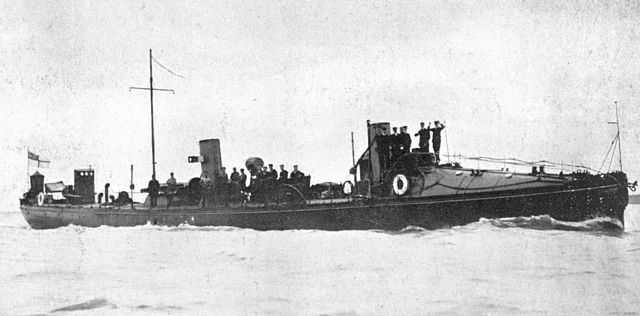
HMS TB 95
 TB 98 (1880)
TB 98 (1880)
A single experimental TB to test the Ruthven turbine, a water jet propulsion by centrifugal pump. She had a hull similar to the second class boats in general, with the boiler placed aft, but disappointed by her poor speed and agility, being unable to go astern and being extra noisy, she could be heard from 10 miles away a calm day.
Specs
Tonnage: 14.5 tons
Dimensions (h:w:l): 66ft 4in x 7.5 x 2.5 ft (20.22 x 2.29 x 0.84m)
Powerplant: 1 shaft Ruthven Turbine, 1 Boiler, 167 ihp
Speed and Autonomy: 11.5 kts
Armament: 2 bow TTs
Crew: 7
 65 footers (1884)
65 footers (1884)
Another expetimental pair by Thornycroft built in 1884 and 1885. The first tested a new model of powerful loco boiler and the second an early experimental watertube boiler.They als introduced the new “semi-tunnel” stern and double rudders for better agility, both encasing the propeller. They were indeed quite agile, but not that fast. Both were discarded after their experiments in the 1890s.
Specs
Tonnage: 12 tons
Dimensions (h:w:l): 65 x 8 x 3-1/2 ft (19.81 x 2.44 x 1.07m)
Powerplant: See notes. 1 shaft Compound TE, 190 ihp
Speed and Autonomy: 16.5 kts
Armament: 2 14-in bow TTs
Crew: 7
 56 Footers (1883)
56 Footers (1883)
White’s twelve small 2nd class Torpedo Boats (TB 1-12) designed to be carried on davits, with two 14-in torpedoes in dropping gear, optional spar torpedo and one or two MGs. They were short but had a larger beam and draft for better seakeeping. Crew rose to nine. They were all wooden-hulled, and built in the White’s turnabout system with a cutaway stern for extra agility. Considered very successful thay had a longer service, becoming the 56 feet picket boats also tested on various ironclads and pre-dreadnoughts of the decade. In fact they became the largest steam boats ever carried by RN capital ships.
Specs
Tonnage: 10-1/2-14 tons
Dimensions (h:w:l): 56 x 9 x 4 ft (17 x 2.82 x 1.45m)
Powerplant: Compound TE, 140-200 ihp
Speed and Autonomy: 15.5 kts
Armament: 2 Torpedoes in lowering cages, see notes.
Crew: 9
 60 Footers (1888-89)
60 Footers (1888-89)
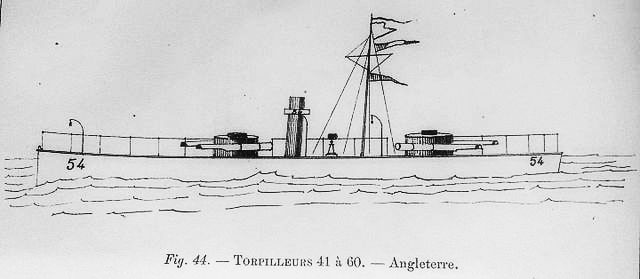
General scheme TB 41, Brasseys
The last 2nd class British Torpedo Boats ever built. Two experimental boats were built by Yarrow in 1888 (TB ), followed by ten in 1889 (TB 39-48) armed all with two 14-in torpedoes in dropping gears and armed with a defensive two-barrel Nordenfelt MG. The second serie were larger and actually made 60 feets. They were also more powerful and beamier, with better seakeeping but the same speed. See the specs below for more. The second serie also was built largely in aluminium, followed thosed ordered by the French Navy. They were also intended to be carried by HMS Vulcan.
Specs
Tonnage: 15-16.5 tons
Dimensions (h:w:l): 59-1/2 -60 x 8/9-1/2 x 3 ft (18.14/29 x 2.51/82 x 0.91m)
Powerplant: Compound TE, 200-240 ihp
Speed and Autonomy: 16.5 kts
Armament: 2 in dropping gear, 1 MG
Crew: 9
“War Scare” Torpedo Boats
 125 Footers, TB 25-87 (1885-87)
125 Footers, TB 25-87 (1885-87)
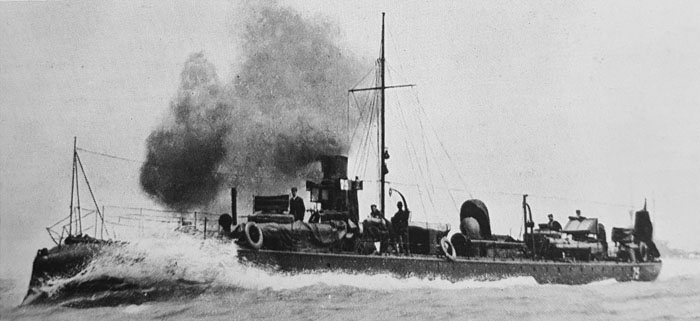
TB-75 in sea trials
![]()
Profile of TB 80
Essentially mass-production resulting from the “war scare” with Russia. After the Lightning-like experiments, and the large 113 footers, tensions with Russia led to a rapid extension of the British defences capabilities, but serial-producing new models by Thornycroft, Yarrow and White. Another factor was simply the fact that both France and Russia, in closer alliance were now in the same path, mass-building torpedo boats. But they were used as “torpedo catcher” at a time the concept of destroyer was not born yet. They were to escort the fleet and counter Russian TB attacks.
Thus one stringent Admiralty requirement was to have them armed with two 3-pdr cannons, and later their Nordenflet MGs were replaced by either a third or the two twin by four-barreled equivalents.
The fix bow TT also became standard.
All in all, 53 vessels built, the largest British Torpedo Boat serie ever. They featured the fixed torpedo tube in a “bull-nose” bow and ram combined. The ram was not meant to be used as such through, but for seakeeping. It was however unsuccessful and when possible, altered by straight bow after entering service, also meaning lossing the bow tube, replaced by a deck tube. T.B. 79 was built by Yarrow to new specs making her 128 feet overall, 25% more in displacement at 75 tonsn and more importantly V.T.E. engines for two funnels, a reshaped hull form to achieve better steering compared to the 125 Footers in general. This was overly successful and applied on the next series TB-80+.
Specs 125 footers (TB25 to 60)
Tonnage: 60 tons standard
Dimensions (h:w:l): 128 x 12 x 6ft (39 x 3.81 x 1.82m)
Powerplant: 1 shaft Compound TE, 2 Loco Boilers, 700 ihp
Speed and Autonomy: 20.5 kts
Armament: 1 bow tube, 2 trainable TTs 14-in, 2x Nordenfelt MGs.
Specs 125 footers (Yarrow Boats, TB 30-33, 61-78)
Tonnage: 60 tons standard
Dimensions (h:w:l): 125 x 13 x 6ft (38.2 x 3.96 x 1.82m)
Powerplant: 1 shaft Compound TE, 2 Loco Boilers, 670 ihp
Speed and Autonomy: 19.5 kts
Armament: 1 bow tube, 2 trainable TTs 14-in, 2x Nordenfelt MGs.
Specs 125 footers (White Boats, TB34-38)
Tonnage: 60-66 tons standard
Dimensions (h:w:l): 125 x 14 x 4ft (38.10 x 4.42 x 1.32m)
Powerplant: 1 shaft Compound TE, 2 Loco Boilers, 950 ihp
Speed and Autonomy: 19 kts
Armament: 1 bow tube, 2 trainable TTs 14-in, 2x Nordenfelt MGs.
The case of TB 79: This unique boat by Yarrow in 1886 was the first fitted with triple expansion engines, and improved hull form to reach greater speeds as well as improve steering. She displaced 75 tonnes for a 128 x 13 ft hull (39.22 x 3.96), 1000 ihp for 22.5 knots, the fastest of the serie. Two funnels and reboilered in 1901. Captain was no other than the future King Georges V. She was BU in 1919.
 TB 39-40 (1882)
TB 39-40 (1882)
This pair was built for Chile, and were sent to the country disasembled when the Russian scare caused the RN to hastily repurchase them in order to bolster the defenses of the Pacific. They were assembled in Chile but escorted to be based in Esquimalt, British Columbia. There, they served as tenders for HMS Swiftsure and were unofficially dubbed by their crews “swift” and “sure”. They were rearmed in 1900 with two new 14-in torpedo models, in dropping gears and 4 barrels Nordenfelt MGs, sold in 1905.
Specs TB 39 Yarrow
Tonnage: 40 tons standard
Dimensions (h:w:l): 100 x 12 x 4ft (30.48 x 3.81 x 1.22m)
Powerplant: 1 shaft Compound TE, 2 Loco Boilers, 500 ihp
Speed and Autonomy: 20 kts
Armament: 1 bow tube, 2x twin Nordenfelt MGs.
 TB 81 “swift” (1884)
TB 81 “swift” (1884)
H.M.S T.B. 81 was built by J. Samuel White as a private venture, then purchased by the Royal Navy for evaluation. She had White’s trademark cut-up stern and ram bow, laid down in 1884 and named “Swift” by her builders. It seems she coud have been built as a destroyer for the Brazilian Navy. She was generally regarded as a curious-looking one, innovationg by being the first fitted with a flush “turtle-back” upper-deck. She also was manœuvred from the top of the oddly shaped conning-tower.
Accommodation however were deplorable. This vessel kept armament options as she was considered as an early destroyer. The pure DD option called for just the bow tube, and up to six 3-pdr, in a role fitting the war scare with Russia. She was reboilered in 1888, with two small funnels, commissioned on 18 July for the 1894 Annual Manoeuvres, leading the Queenstown Division, Blue Side. In 1895, classed as a 125 feet she was stationed in Portsmouth, but ran aground off Alderney in 1901, salvaged, reboilered in 1905 with small tubes, collided in 1906 with TB 108. She was kept out of commission most of the time and used as senior flotilla officer’s boat. She survivd WWI and was sold on 22 October 1921.
Specs TB 81 White
Tonnage: 137 tons standard
Dimensions (h:w:l): 153 x 17 x 9ft (46.85 x 5.33 x 2.90m)
Powerplant: 1 shaft Compound TE, 2 Loco Boilers, 1330 ihp
Speed and Autonomy: 23.5 kts
Armament: 1 bow tube + 2 on deck, 4x 3pdr, 2x twin Nordenfelt MGs.
 TB 80 (1886)
TB 80 (1886)
These were the first fitted with a turtleback bow intended to deal with heavy weather and to be seaworthy. This influenced the construction of all subsequent TBs and early destroyers before the introduction of the forecastle with the River class. She was initially based on a design for Austria, and sometimes called the “Falke” type.
Considered superior to the later TB 82 type, with better seaworthiness and agility; However she was reboilered in 1898 with small water tubes types, ging from one to two funnels. A powerful ship as planned as she was to be equipped with two pairs of TTs, but it was chosen instead a bow TT and four 3-pdr for anti-torpedo boat work, a bit like TB 80. She served in one of the patrol flotillas in WWI and was BU in 1921.
Specs TB 80 Yarrow
Tonnage: 105 tons standard
Dimensions (h:w:l): 135 x 14 x 6ft (41.15 x 4.27 x 1.83m)
Powerplant: 1 shaft Compound TE, 2 Loco Boilers, 500 ihp
Speed and Autonomy: 23 kts
Armament: 1 bow tube + 2 on deck, 3x 3pdr, 2x twin Nordenfelt MGs.
 130 Footers (TB 82-87) (1884)
130 Footers (TB 82-87) (1884)
Also called 130 Footers, this small serie was generally similar to TB 79, but with the new turtleback forward. Too lightly built they were not a success, being buffed up after initial service. In 1900-1902 these six vessels were reboilered with watertube models. Apparently assigned to the Mediterranean. TB 84 wans in collision in 1906, the orhers served in WWI.
Specs TB 82 Yarrow
Tonnage: 85 tons standard
Dimensions (h:w:l): 130 x 13 x 5ft (39.67 x 4.14 x 1.75m)
Powerplant: 1 shaft Compound TE, 2 Loco Boilers, 1,800 ihp
Speed and Autonomy: 23 kts
Armament: 1 bow tube + 2 on deck, 3x 3pdr, 2x twin Nordenfelt MGs.
 140 Footers, TB 21-24 (1884-86)
140 Footers, TB 21-24 (1884-86)
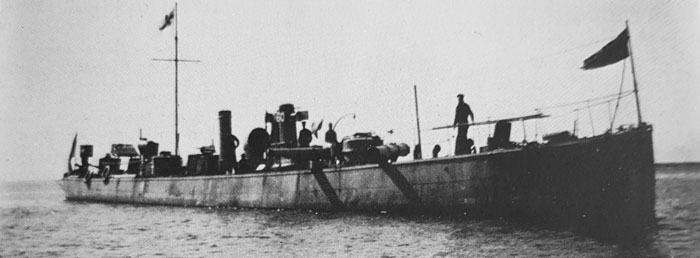
![]()
This peculiar serie came just as the admirakty also ordered its first destroyers. Ten first-class torpedo boats called “140 Footers” in reference to their greater size, three by Yarrow being considerably smaller than the others, but beamier than the T.B. 82 class (“130 Footers”).
They entered service in 1894, starting exercizes that year and the next, all were delivered, six being sent for the defence of Gibraltar.
They had a single bow fixed 18-in torpedo tube plus two trainable tubes on deck aft, apparently parallel on single mountings, possibily in opposite directions. They also had three 3-pdrs for self-defence. By mid-1904, the 5-barrel .45-in Nordenfelt machine guns were replaced by .45-in Maxim guns, extended to the 125 footers.
Yarrow Boats: 105 tons, T.B. 88 and 89 slightly longer (142 feet) 23.5 knots/1850 I.H.P. T.B. 90 made 23 knots on 1500 I.H.P thanks to a new 4-cylinder engine plus new experimental water-tube boilers by Thornycrof. Unsuccessful however it seems.
Thornycroft Boats: T.B. 91 and 92 were heavier at 141 tons, for 24.5 knots. T.B. 91 was 142.5 feet long as her propellor placed further aft. They had 4-cylinder TE engines fed by early water-tube boilers. T.B. 93 displaced 136 tons for 140.5 feet but inaugurated twin screws for better agility, a first.
White Boats: Three 130 tons, 23 knots (2000 I.H.P.) made at Maudslay, Sons with locomotive boilers, re-boilered later with water tube types.
Laird: The 130 tons, 140 feet 4-in T.B. 97 had its locomotive boilers replaced by water tube boilers in 1909. She reached 23 knots on 2000 ihp.
Specs (Yarrow 1894)
Tonnage: 105 tons
Dimensions (h:w:l): 142 x 14 x 7 ft (43.28 x 4.50 x 2.29m)
Powerplant:1 shaft TE, 2x Loco boilers, 1850 ihp, 23.5 kts
Armament: 1 bow tube, 2x trainable TTs, 2x 3-pdr, 2x Nordenfelt MGs
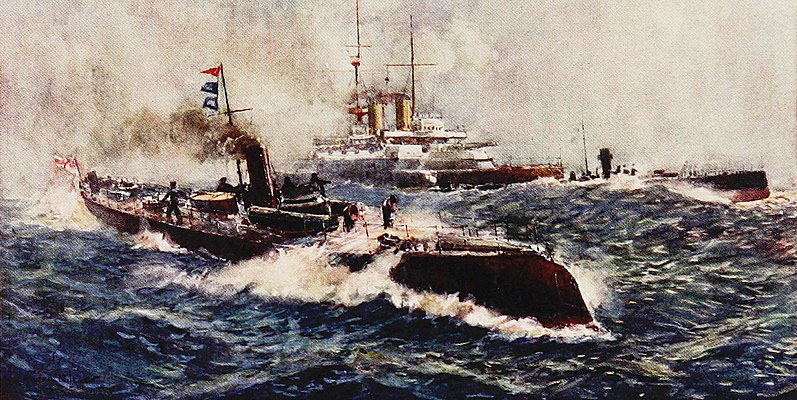
TB 97 (White’s early ram bow tube type) in manoeuver, escorting a pre-dreadnought in rough seas, 1907
Torpedo Boats actually registered in WWI
 160 Footers (1900-1905)
160 Footers (1900-1905)
HMS TB98, 99, 107, 108, 109-113, 114-117
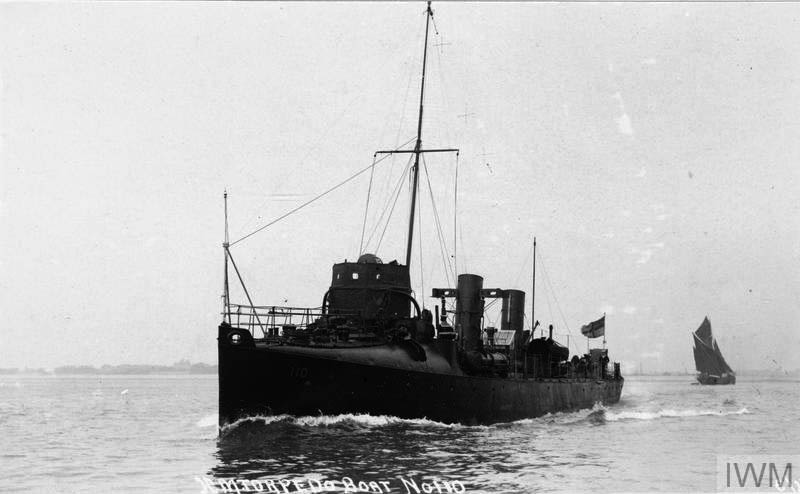
TB 110 underway
The last torpedo boat class, developped in parallel to the last 33-knotters and experimental turbine boats. Their inferior speed of 25 knots and range have them largely considered technological dead-ends. They could have been saved by adopting the turbine, but the admiralty decided at this point to concentrate all efforts into modern fleet destroyers instead, leaving torpedo boats for point defence.
The last class called “160 footers” related to their size (50 m on average) were distributed among two yards, Thornycroft (Four of the early type, five of the late type), and White (4), for thirteen boats total. They did their share in WWI, notably patrolling the channel and coastal areas in general. They were poorly armed to face U-Boats through, and were mostly intended to combat German TBs from Belgian ports, notably Zeebruge.
Serie I Thornycroft (1900):
Serie II Thornycroft (1901):
White (1902): Slightly larger than their Thornycroft cousins, and little different in design. Only TB 117 was lost in WWI, but due to collision. The rest were BU 1919-21.

Profile of TB 109
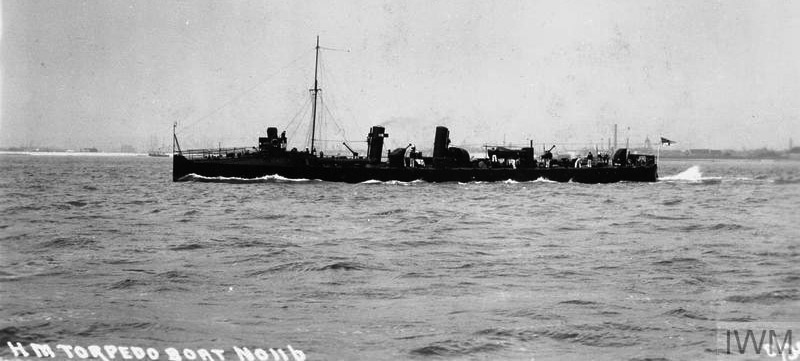
TB 116 on sea trials
Specs White’s 160 footers
Tonnage: 219 tons standard
Dimensions (h:w:l): 166 x 17 x 5-1/2 ft (50.29 x 5.33 x 1.68 m)
Powerplant:
Speed and Autonomy:
Armament:
The Cricket class (1905)
 Cricket class
Cricket class
TB 1-36 Cricket, Gadfly, Mayfly, TB 13 sub-classes (1905-1909)

It is important to note here, these were not considered torpedo boats until October 1906, 1st class torpedo boats to be exact. But they had been designed and called as “coastal destroyers”. In late 1906, the serie was ongoing and they were thus completed (including TB 1) as “torpedo boats” indeed, relevant to this topic. They resurrected the old numeration, from TB 1 to TB 36. For once, instead of a collection of prototypes, French-style, the RN had a potent defensive force for the Channel fleet (mostly) made of the latest tech. Several Yards took part in their construction and they were subdivided into three sub-classes:
–Cricket class (1905-1906 programme) TB 1-5 all built in J. Samuel White
–Gadfly-class (same) TB 6 to TB 10 by Thornycroft
–Mayfly class (same) TB 11 and TB 12 by Yarrow
–TB 13 class (same, unnamed at this point), TB 13-36 by White, Denny, Thornycroft, Yarrow, Hawtorne, Palmers. The last, TB 36, was completed in September 1910.
They had a fairly short career, rendered virtually obsolete by the much cheaper CMB boats in WWI, and retired/scrapped in 1921 to save treaty tonnage.
Design-wise, they introduced a serie of “firsts” since 1900 and the design of the 160 footers. At first, the torpedo boat destroyers (TBDs) were intended to complement the Tribal-class destroyers. Soon, it was realized they were not strong enough for open ocean operations, thus reclassified as 1st class torpedo boats. They differed in detail per shipbuilder but all had two funnels, torpedo tubes on the stern and broadly resembled the 26-knotter TBDs with their turtle-back forecastle. However they had this time Parsons Turbines, and oil-fired watertube boilers, a powerful combination giving them 3,600 shp (2,700 kW) and 26 knots (48 km/h; 30 mph) while their three shafts and two rudders gave them unprecedented agility. They were better suited for longer missions and patrols, however still cramped and wet.
By 1914 they were all in the North Sea Patrol Flotillas, or in the Nore Flotilla. TB 4 and TB 24 illustrated themselves engaging their German peers of the Belgian Coast in 1915. By 1918 the four Denny boats went to the Mediterranean at Gibraltar and Malta.
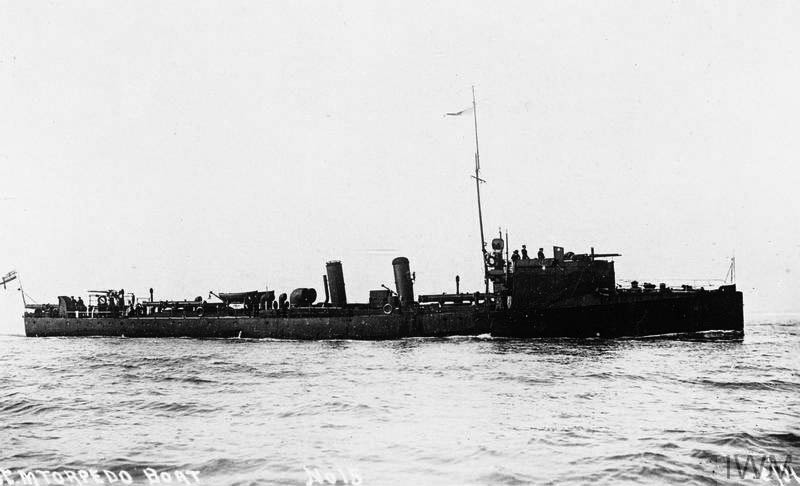
TB 15, Cricket class (IWM)
Specs, HMS Cricket
Tonnage:247 t normal, circa 272 t deep load
Dimensions (h:w:l):178 ft oa x 17 ft 6 in x 6 ft 1.5 in ( x 5.33 x 1.867 m)
Powerplant: 3shafts, 2 Yarrow boilers, 3 Parsons turbines: 3,600 shp (2,700 kW)
Speed and Autonomy: 26 knots (48 km/h; 30 mph), 21.7–37 t of oil
Armament: 2× 12-pdr guns, 3× 18-inch torpedo tubes
Crew:39
Colonial Torpedo Boats

HMS Acheron plans
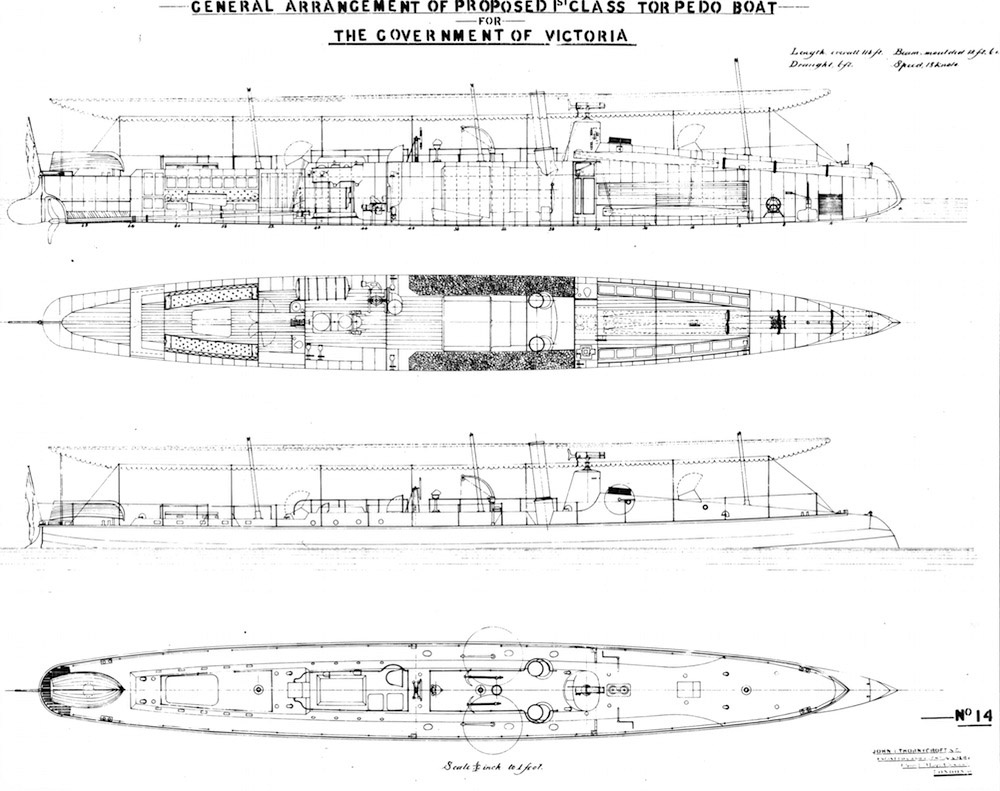
HMS Childers plans
As a point-defence vessel, the torpedo boat was ideal to replace a cruiser, and faster to react than a gunboat.
Australian & NZ 2nd class vessels
In 1879, New South Wales received HMAS Acheron and Avernus, built on Thornycroft plans in Sydney: 16t, 78ft, 300 ihp for 16kts
Victoria received in 1884 the HMAS Nepean and Longsdale from Thornycroft, 63ft models broadly similar to the Acheron.
Also in 1884 came HMAS Childers (65t, 113ft, 670ihp, 19kts, 2×15 TTs, 3pdr)
And in 1890 HMAS Countess of Hopetown by Yarrow (82t, 130ft, 1150 ihp, 23kts, 3x 14in TTs, 3-3pdr)
Tasmania received a 1884 single Thornycroft unnamed spar TB (63ft, 17 kts, 1x Nordenfelt MG).
New Zealand received four boats, numbered 1-4, built in Thornycroft in 1883, shipped a year later, close to the Tasmanian boat, but in 1885 they had sets of two dropping gears installed; They were BU in the late 1910s.
Indian 130 footers
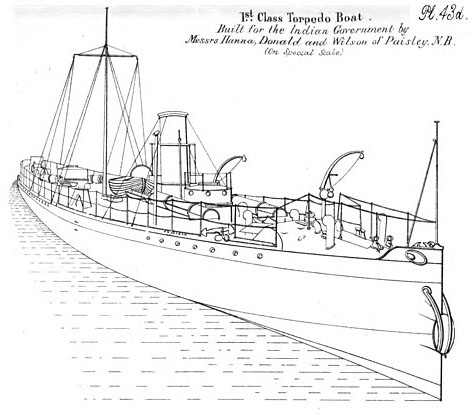
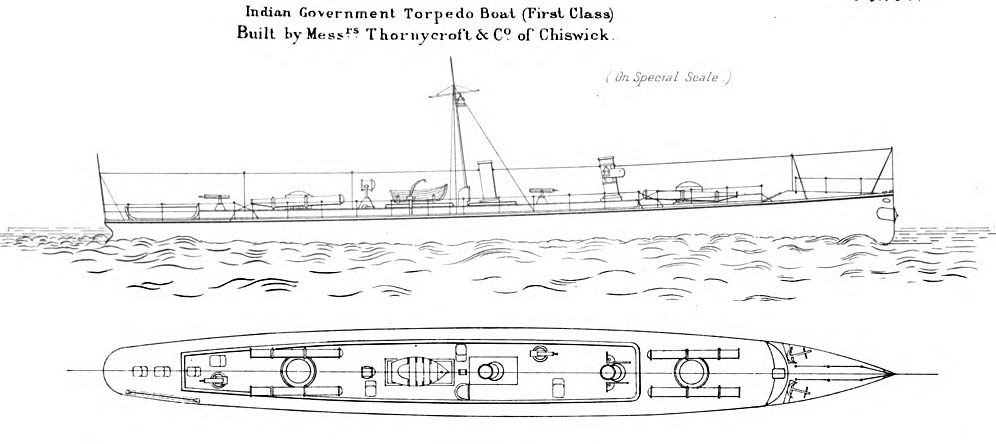
Gurkha and another Indian TB in Brasseys Annual
Six very different ships were sent to the RIN (Indian stations): TB-100 to TB-106. They greatly differed by their yard and were all ordered in 1887 by the Indian office. Loosely based on the 125 footer design, they were the following:
-TB 100 to 103, Thornycroft 1887 (96t, 134ft, 1260 ihp, 23 kts)
-TB 101, Hanna & Co 1888 (92t, 135ft, 1000 ihp, 21 kts)
-TB 104 to 106, White 1889 (95t, 134ft, 1000 ihp, 22 kts)
They were renamed Baluchi, Karen, Pathan, Gurkha, Mahratta, Sikh, Rajput and served in WWI, BU 1919.
British Torpedo Boats in WWI
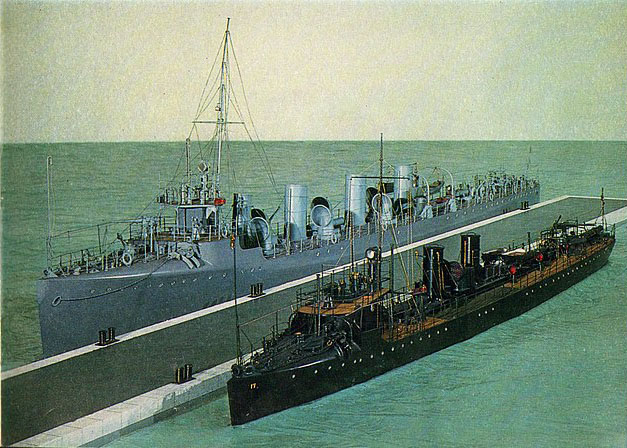
HMS TB 17 (Cricket class) in black livery at a mole alongside HMS Tartar, 1907
British Torpedo Boats were not many so see action in WW1. Of the still active class in August 1914 were 34 boats of the 125, 130, 140, 150 and 160 footer, plus the new 36 Cricket Boats. The last 2nd class, TB 6, was discarded in 1906 and sold in 1912. So that made for a fleet of no less than 70 TBs, not unsignificant. They mostly had been redirected to point defence in the colonies, keeping only the more recent, quite a few, for home Defence. This was in addition to the the 160 footers and of course the Cricket class. Those stationed at Gibraltar, the Cape, Malta, or Singapore, saw little action and spent their career in dull patrols.
The 125-140 Footers in action:
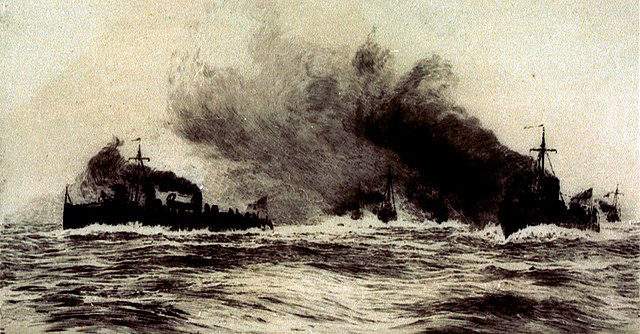
Some should have been active in WWI but were lost or discarded prior: TB 56 foundered off Damietta on 17 May 1906 while in tow, TB 59 ended as target, sold 1912. TB 84 sank in collision with the destroyer HMS Ardent on 17 April 1906. TB 98 sank in collision in 1907 but was salvaged and repaired.
For those in home waters, that was another story. Given their short range, the 140-160 footers in various ports of the east coast were mobilized for patrols and as the war progressed, equipped when possible with depht charges and hydrophones. The “oil wad” were considered as coastal destroyers, and divided between the Local Defence Flotilla, Firth of Forth (about 24 boats) and the LDF based in Newcastle, Sheerness and Portsmouth. TB 98 to 117 were in Portsmouth. TB 90-97, 86, 88, 89 formed the Gibraltar home flotilla. TB 42, 44, 46, 63, 70 formed the Malta defence flotilla in August 1914. But they were all sent to the Suez Canal in 1915, and indeed played a deterrence against the Turks, notably during the sole crossing attempt.
The remaining ones were used in home waters for various duties with reduced crews, needed elsewhere. TB 46 made a run between Port Said and Mudros but ran out of coal and was stranded on Lemnos on 27 December 1915. She was later refloated and repaired. TB 64 was wrecked in the Aegean sea, 21 March 1915. TB 90 capsized in heavy weather off Gibraltar on 25 April 1918. TB 97 collided with the troopship Tringa off Gibraltar on 1st November 1915. TB 117 sank in collision with SS Kamouraska in the channel on 10 June 1917.
The 160 Footers in action:
For the four boats of the TB 114 class (160 footers): In November 1911, TB 115 was a tender to the torpedo school HMS Actaeon and the remainder part of The Nore torpedo boat flotilla with skeleton crews by February 1913. TB 116 was versed in the Portsmouth Flotilla. TB 114 was modified as the senior officer’s (Nore flotilla), colliding with TB 18 in April 1913 and repaired at Chatham afterwards. They were still in the Nore and Portsmouth flotillas by July 1914 and served with local defence flotillas there.
On 13 October 1914, TB 116 spotted U-20 off Culver Cliff (Isle of Wight), opened fire but was not quick enough to close and ram her. She had no DCs and the U-Boat dove and disappeared. TB 117 was sunk in collision with SS Kamouraska as said above and the remainder stayed in their local defence flotillas until December 1918. In 1919 only TB 116 was in service as a tender, Portsmouth and then for cadet training, sold in 1921.
TB 81
, the “TB catcher”, served as a patrol boat operating out of Portsmouth and Portland, fitted with hydrophones and depth charges to hunt down U-Boats. On 15 May 1917 she spotted and directed a seaplane towards one, attacked in the English Channel. TB 81 detected another until UB-36 or UB-20 surfaced and was chasen off until diving, depth-charged, producing a patch of oil. A “possible” success credited by naval intel that could have been the only one by a WWI TB during the war.
It would be just too long to span their entire record logs, most of these were not quite interesting anyway. As the war ended, they were all sold in July to December 1919, and a few in January-June 1920 except TB 80-82, 85, 86 and 116, kept in service until October 1921.
The Cricket class in action:
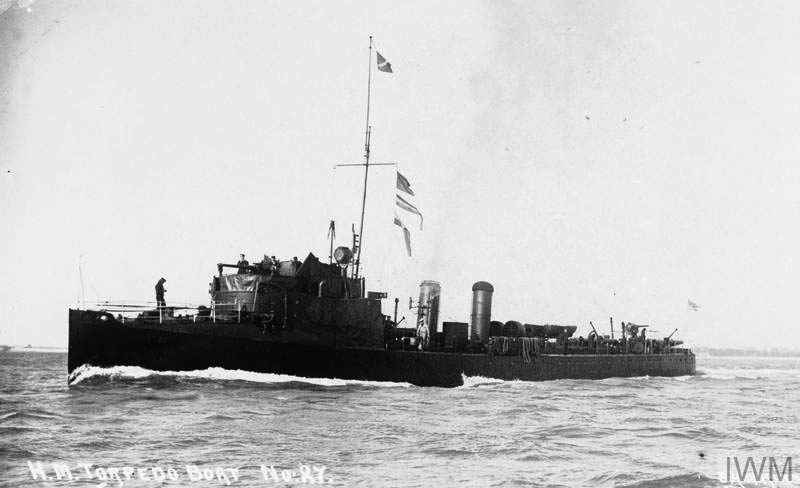
TB 27
As for the more modern Cricket class, TB 4 in 1912 was part of the four Patrol Flotillas formed with torpedo boats and older destroyers to prevent any enemy minelaying or torpedo attack attempt on the east coast. She was in 1913 in the 8th Flotilla, Chatham and in 1914, 7th at Devonport, then 1915 9th, and 6th (Dover Patrol). On 17 November 1915, she assisted the sinking hospital ship Anglia, saving many lives by taking on board all that she could. On the night of March 17/18 1917 during an importan German raid, she spotted the German torpedo boats shelling targets on land, reported it but failed to catch them up. On the night of 26/27 April 1917, the same repeated off Kent, with the shelling of Margate, Ramsgate and Broadstairs, also spotted by TB 4 and trie to close to deliver a torpedo attack, but it was too late as the forced already folded out.
TB 5, another early boat of the class, was also in the 8th Flotilla (Chatham) and by 1914, 7th at Devonport. In February 1915 she escorted a convoy to Newhaven with stores ships sailing from France. On 23 February, she chased the hunt for U-8 off Beachy Head based in Ostend. She was based afterwards to Portsmouth command to escort transports from Southampton. On 3 September 1916, SS Johan Siem was stopped off Newhaven by a German submarine but TB 5 came in time from Newhaven, driving it off and escorting the Danish steamship back to Newhaven. On 3 May 1917 she rescued the victims of UB-40. On 6 June 1917 she spotted an U-Boat which dove away, and attacked her with four depth charges, but success by naval intel was judged “Improbable”.
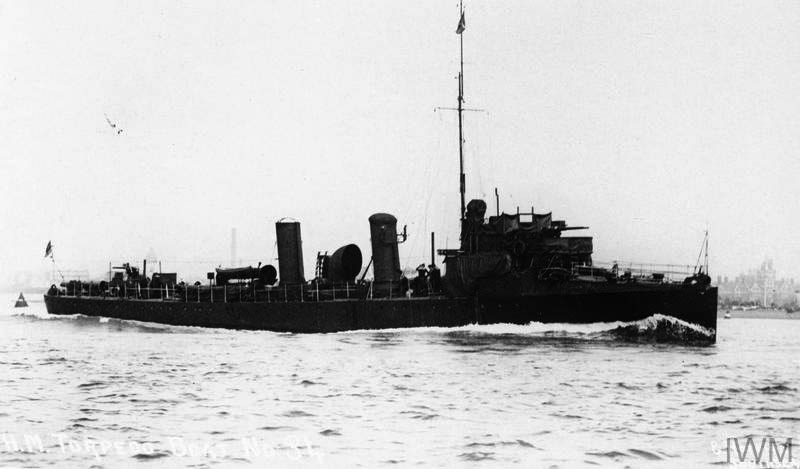
TB 31
TB 9 on 23 November 1914 chased off the rampaging U-21. On the morning of 24 November 1914, with HMS Conflict, she escorted transports from Harwich but on 26 July 1916 TB 9 was sunk in collision with HMS Matchless, herself damaged after colliding with HMS Manly).
TB 13 was part of the 7th Flotilla at Devonport and 8th at Chatham by July 1914, 8th in November (Tyne), escorted transports and took part in ASW sweeps. She was lost in a collision (North Sea) on 26 January 1916.
TB 23 by March 1913 was in Chatham, until July 1914, versed in November to the Nore’s Local Defence Flotilla, defending the Thames Estuary, until December 1918.
These are just chips among the whole class.
Inheritance
The last British TBs were scrapped soon after the end of WWI, 1919 for most. In between, an even lighter craft, yet still capable of carrying a torpedo was devised: The CMB for “Coastal Motor Boat”. Thanks to rapid development of more powerful engines mostly driven by the aviation industry, and light hulls pioneering new construction techniques, the first motor-boats developed at the end of the war looked like a way cheaper solution to deliver the same deadly payload.
It would evolve in small quantities during the interwar and “explode” in many forms in WW2, then evolving during the cold war as the fast attack craft, definitely discarding the torpedo for missiles in the 1960s, exactly a full century after the first experimental torpedo boats. The legacy continues today, widespread in small navies, proving this old concept for coastal defence is still relevant regardless of the final payload.
Read More/Src
spar TB on weaponsandwarfare.com
Confederate TBs and mines
Charles A. PARSONS
The Whitehead Torpedo
navweaps.com Pre WWI torpedoes
jstor.org LAST LINE OF DEFENCE: A BRIEF HISTORY OF THE TORPEDO BOATS AND TORPEDO BOAT SUPPORT FACILITIES OF COLONIAL NEW SOUTH WALES James W. Hunter, III
Wiki list
hmas childers on navy.gov.au
On gutenberg.org Torpedoes and Torpedo Warfare, by C. W. Sleeman
Yarrow built kotaka design
herreshoff designs
Brown, D. K. (2003). Warrior to Dreadnought: Warship Development 1860–1905. London: Chatham Publishing
Friedman, Norman (2009). British Destroyers: From Earliest Days to the Second World War. Barnsley, UK: Seaforth Publishing
Hythe, Viscount, ed. (1912). The Naval Annual 1912. Portsmouth, UK: J. Griffin & Co.
Gardiner, Robert; Lambert, Andrew, eds. (1992). Steam, Steel & Shellfire: The Steam Warship 1815–1905.
Moore, John (1990). Jane’s Fighting Ships of World War I. London: Studio Editions.
Gardiner, Robert. Conway’s All the World’s Fighting Ships 1906–1921
Gardiner, Robert. Conway’s All the World’s Fighting Ships 1860–1905
Model kits
Nothing found so far… Feel free to suggest any via the comments below.
Many thanks in advance !



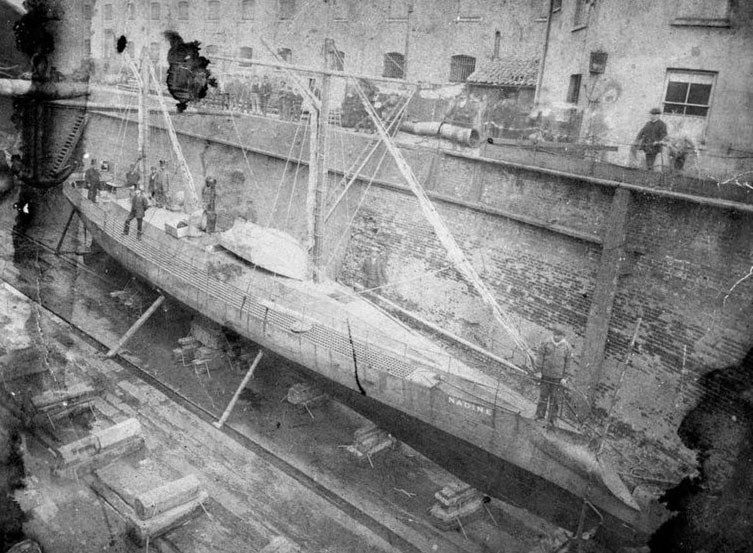
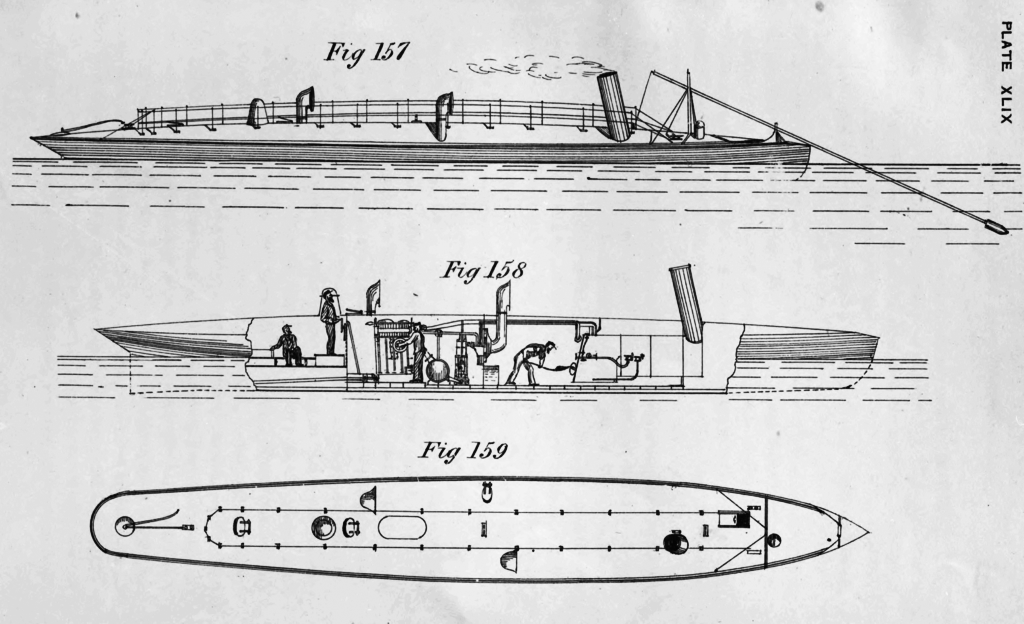
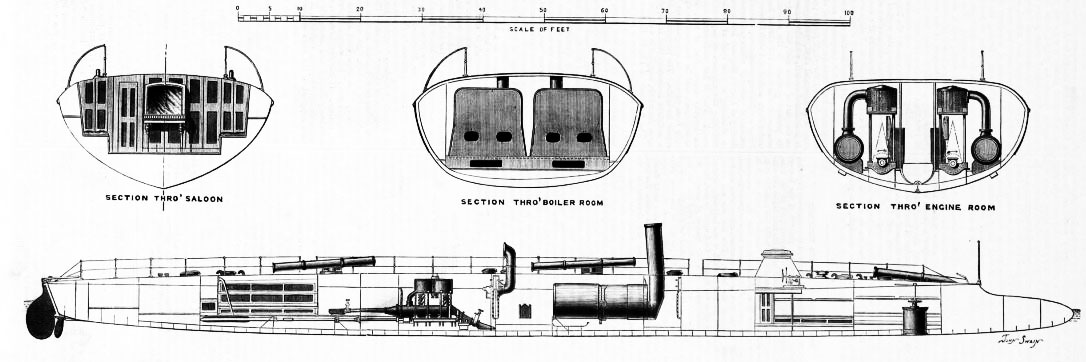
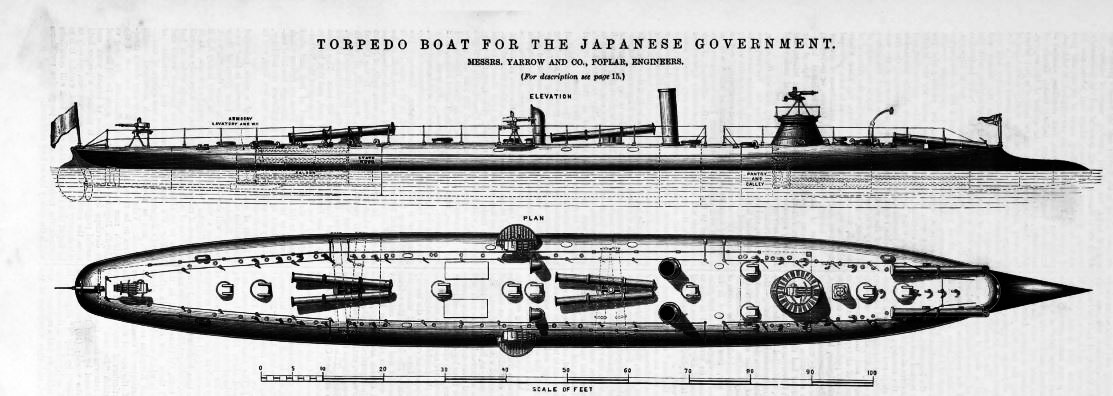
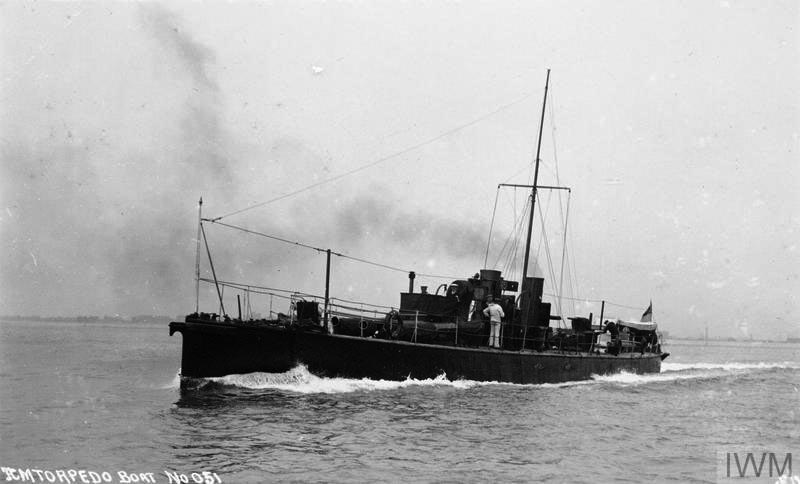
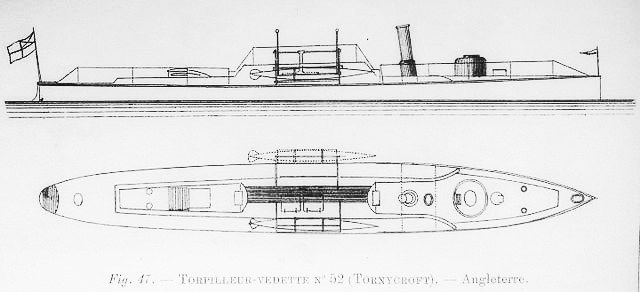
 Latest Facebook Entry -
Latest Facebook Entry -  X(Tweeter) Naval Encyclopedia's deck archive
X(Tweeter) Naval Encyclopedia's deck archive Instagram (@navalencyc)
Instagram (@navalencyc)





 French Navy
French Navy Royal Navy
Royal Navy Russian Navy
Russian Navy Armada Espanola
Armada Espanola Austrian Navy
Austrian Navy K.u.K. Kriegsmarine
K.u.K. Kriegsmarine Dansk Marine
Dansk Marine Nautiko Hellenon
Nautiko Hellenon Koninklije Marine 1870
Koninklije Marine 1870 Marinha do Brasil
Marinha do Brasil Osmanlı Donanması
Osmanlı Donanması Marina Do Peru
Marina Do Peru Marinha do Portugal
Marinha do Portugal Regia Marina 1870
Regia Marina 1870 Nihhon Kaigun 1870
Nihhon Kaigun 1870 Preußische Marine 1870
Preußische Marine 1870 Russkiy Flot 1870
Russkiy Flot 1870 Svenska marinen
Svenska marinen Søværnet
Søværnet Union Navy
Union Navy Confederate Navy
Confederate Navy Armada de Argentina
Armada de Argentina Imperial Chinese Navy
Imperial Chinese Navy Marinha do Portugal
Marinha do Portugal Mexico
Mexico Kaiserliche Marine
Kaiserliche Marine 1898 US Navy
1898 US Navy Sovietskiy Flot
Sovietskiy Flot Royal Canadian Navy
Royal Canadian Navy Royal Australian Navy
Royal Australian Navy RNZN Fleet
RNZN Fleet Chinese Navy 1937
Chinese Navy 1937 Kriegsmarine
Kriegsmarine Chilean Navy
Chilean Navy Danish Navy
Danish Navy Finnish Navy
Finnish Navy Hellenic Navy
Hellenic Navy Polish Navy
Polish Navy Romanian Navy
Romanian Navy Turkish Navy
Turkish Navy Royal Yugoslav Navy
Royal Yugoslav Navy Royal Thai Navy
Royal Thai Navy Minor Navies
Minor Navies Albania
Albania Austria
Austria Belgium
Belgium Columbia
Columbia Costa Rica
Costa Rica Cuba
Cuba Czechoslovakia
Czechoslovakia Dominican Republic
Dominican Republic Haiti
Haiti Hungary
Hungary Honduras
Honduras Estonia
Estonia Iceland
Iceland Eire
Eire Equador
Equador Iran
Iran Iraq
Iraq Latvia
Latvia Liberia
Liberia Lithuania
Lithuania Mandchukuo
Mandchukuo Morocco
Morocco Nicaragua
Nicaragua Persia
Persia San Salvador
San Salvador Sarawak
Sarawak Uruguay
Uruguay Venezuela
Venezuela Zanzibar
Zanzibar Warsaw Pact Navies
Warsaw Pact Navies Bulgaria
Bulgaria Hungary
Hungary

 Bundesmarine
Bundesmarine Dutch Navy
Dutch Navy Hellenic Navy
Hellenic Navy Marina Militare
Marina Militare Yugoslav Navy
Yugoslav Navy Chinese Navy
Chinese Navy Indian Navy
Indian Navy Indonesian Navy
Indonesian Navy JMSDF
JMSDF North Korean Navy
North Korean Navy Pakistani Navy
Pakistani Navy Philippines Navy
Philippines Navy ROKN
ROKN Rep. of Singapore Navy
Rep. of Singapore Navy Taiwanese Navy
Taiwanese Navy IDF Navy
IDF Navy Saudi Navy
Saudi Navy Royal New Zealand Navy
Royal New Zealand Navy Egyptian Navy
Egyptian Navy South African Navy
South African Navy






























 Ukrainian Navy
Ukrainian Navy dbodesign
dbodesign